概要
2018年度より大気圏物理学講座(気象学研究室・物理気候学研究室)の合同コロキウムを実施しています(不定期開催)。どなたでもご参加頂けますので、多くの皆様のお越しをお待ちしています。発表者も随時募集しています(世話人(坂崎)までご連絡ください)。
発表リスト
2025 (R7) 年度
| 実施回(月日) | 発表者(所属・身分): タイトル | 写真 |
第27回 (2025年 12月07日 15:00-16:30) 1-563 |
齋藤 泉 氏(名古屋工業大学工学研究科 准教授) [タイトル・要旨] "雲マイクロ物理シミュレータによる雲乱流現象の解明" 雲と乱流は、天気予報を含む気象モデルにおいて重要な要素であるにも係わらず、それらに関する知識は限られている。雲の内部では、乱流が熱、水蒸気、エアロゾル、氷、雲粒、雨滴などを輸送・混合する。同時に、これらは非常に広いスケール範囲に亘って乱流を変調させ、高度に非線形かつ非平衡な複雑系(雲乱流)となっている。雲乱流現象の理解を目指して、我々は、乱流的な雲内環境における乱流及び、雲粒から雨粒への成長を第一原理に基づいてシームレスにシミュレートするための直接数値シミュレーション(Direct Numerical Simulation, DNS) モデルである「雲マイクロ物理シミュレータ」を開発してきた。本講演では、雲粒の凝縮・衝突成長に対する乱流の影響、雲チャンバー実験との比較、乱流ゆらぎに対する雲粒子の影響など、雲マイクロ物理シミュレータの最近の進展と成果について概説する。 (補足: 本講演は, 集中講義「雲乱流の科学」の一環として実施されます.) |
|
第26回 (2025年 08月07日 10:30-12:00) 1-355 |
Meng-Tze Lee (Department of Atmospheric and Oceanic Sciences, McGill University) [タイトル・要旨] "Continuous Ranked Probability Score (CRPS)- based ensemble down-selection for hourly precipitation forecasting with preserved ensemble spread and reduced computational cost" An ensemble down-selection method is proposed to improve the analysis and forecast with a small ensemble, reducing computational needs. A usual problem with ensemble down-selection is that, despite the reduction of forecast error, ensemble spread sharply decreases. To limit ensemble spread collapse, this study introduces two variations of a novel down-selection method seeking to minimize the sub-ensemble’s Continuous Ranked Probability Score (CRPS), thereby preserving ensemble spread while minimizing forecast error. The approaches are then tested with a regional-scale model whose precipitation forecast we seek to improve. The precipitation forecast performance of sub-ensembles obtained by these CRPS-based methods is evaluated against 100 randomly down-selected sets using various verification metrics measuring precipitation forecast skill. Results demonstrate that the CRPS-based sub-ensembles improve probabilistic forecast accuracy by achieving lower CRPS with the lowest Root Mean Square Error (RMSE) value, especially for short forecasts, with decreasing false alarms. Additionally, the Brier Score shows improved forecasts, while Fraction Skill Score (FSS) confirms the improved spatial accuracy in light precipitation. These findings suggest that CRPS-based methods are viable sub-ensembling approaches for balancing accuracy, reliability, and computational efficiency in operational forecasting. By preserving ensemble spread, they improve the sub-ensemble's capacity to represent uncertainty, offering a practical and robust solution for ensemble down-selection. |
|
2024 (R6) 年度
| 実施回(月日) | 発表者(所属・身分): タイトル | 写真 |
第25回 (2024年 07月25日 13:15-14:45) 1-563 |
Prof. Bo Wu (Institute of Atmospheric Physics, Chinese Academy of Science) [タイトル・要旨] "Theories on anomalous anticyclone over western North Pacific during El Nino" The western North Pacific anomalous anticyclone (WNPAC) is the most important low-level circulation system that connects El Niño and the East Asian monsoon. Here, I will review various theories on the formation and maintenance of the WNPAC from El Niño mature winter to El Niño decaying summer, including warm pool atmosphere-ocean interaction, Indian Ocean capacitor, a combination mode that emphasizes nonlinear interaction between ENSO and annual cycle, moist enthalpy advection/Rossby wave modulation. It is concluded that moist enthalpy advection/Rossby wave modulation mechanisms are essential for the initial development and maintenance of the WNPAC. |

|
第24回 (2024年 05月10日 10:30-12:00) 1-563 |
小寺邦彦(京都大学理学部 研修員) [タイトル・要旨] "熱帯成層圏・対流圏結合における対流圏界層に貫入する深い対流雲の役割" 極域における成層圏・対流圏結合では極夜ジェットと惑星波という大規模な循環場の相互作用が重要な役割を果たしているので、 その過程の同定は比較的容易であった。一方、熱帯における成層圏・対流圏結合では対流圏界層に貫入する深い対流雲の働きが 重要と考えられるが、全球的な観測、モデルは共に不十分である。ここでは、幾つかの事例について、熱帯における成層圏循環 の変化がどの様に対流圏に及ぶかについて議論を試みる。まず成層圏突然昇温に伴う変動がどの様なプロセスを経て熱帯対流圏 に達するかについて述べる。また、2019年9月の南半球突然昇温の場合について対流圏界層の上昇流の強化がハリケーンの発達に 寄与した例を示す。次に、北半球夏季における対流圏温暖化・成層圏寒冷化のトレンドに伴って生じる対流圏界層内の対流の発達に ついて示す。全球的にはこれは、ハドレー循環の深い上昇枝の発達と考えられよう。地域的には、アフリカではTalor et al. (2017)が 示している様に貫入対流の発達が著しい。このサヘル域について貫入対流と対流圏界層の寒冷化の関係について示す。また、アジア域でも ハドレー循環の上昇域の強化が見られるが、これと2022年8月初旬のアジア域(日中韓)での鉄砲水洪水との関係について述べる。 以上から、近年の気候変動における対流圏界層に達するメソスケール対流システムの重要性が示唆されるが、 再解析データ、特にERA5ではこの効果が十分に表現されていない。温暖化にともなう異常気象の研究についてはこの改善が是非とも必要であろう。 |

|
2023 (R5) 年度
| 実施回(月日) | 発表者(所属・身分): タイトル | 写真 |
第23回 (2024年 02月22日 16:00-17:30) 1-563 |
Christopher R. Williams(University of Colorado Boulder, Research Professor) [タイトル・要旨] "Retrieving Raindrop Size Distribution Parameters and Vertical Air Motion from Micro Rain Radar (MRR) Observations" Micro Rain Radars (MRRs) are small 24-GHz frequency modulated continuously wave (FMCW) commercial meteorological vertically pointing radars manufactured by Metek Meteorologische Messtechnik GmbH in Germany. The MRR is a robust radar capable of operating during rain and snow and provides real-time products including vertical profiles of radar reflectivity factor and rain rate. The MRR real-time algorithms assume zero air motion in the precipitating column, which may be valid during stratiform rain, but is not valid during convective rain. To advance our understanding of microphysical rain and snow processes, a new retrieval algorithm was developed using profiles of MRR Doppler velocity power spectra to estimate vertical air motion and raindrop size distributions throughout the precipitating rain column. The new retrieval algorithm is based on a forward radar Doppler velocity spectrum simulator developed to retrieve air motion and raindrop size distributions (DSDs) from two vertically pointing radars operating side-by-side and at different frequencies. The differences between Rayleigh and Mie scattering at the two different radar operating frequencies provides unique information to constrain possible solutions. In contrast, the new retrieval algorithm uses profiles from the single frequency MRR, which will have larger uncertainties than the two-frequency retrieval method. One objective of my visit to Kyoto University is to quantify the single frequency uncertainties by comparing the single- and two-frequency algorithms using side-by-side MRR and MU radar observations. |

|
第22回 (2023年 10月05日 10:30-12:00) 1-563 |
Nili Harnik(Tel Aviv University・Professor) [タイトル・要旨] "Turbulence, waves and jets in a dry and moist tropical planet" Satellite image-movies of clouds show an intricate variety of shapes of cloudy-areas moving around and changing constantly, on a multitude of spatial scales. Specifically, we see an organization of convection into coherent large-scale structures, as part of moist tropical systems. These large-scale moist systems, by diverse means, play a major role in shaping the kind of weather occurring during a given season, and are responsible for much of the extreme weather in the tropics. Spectral analysis of brightness temperatures - a proxy for deep convection- reveals peaks along linear dispersion relation curves for planetary scale waves, alongside a red noise spectrum. This coexistence of waves and turbulence in the tropics has not been studied before, and specifically, whether the planetary scale waves can be excited via an upscale turbulent cascade from mesoscale convective systems. We will examine this in a simple model run in tropical-planet configuration, in which there are no large-scale gradients in heating or sea surface temperatures. This allows us to examine these interactions without the influence of midlatitude weather. We find that mesoscale structures aggregate to larger scales only if vorticity anomalies are excited strongly enough. The process of convection aggregation from cloud scale to mesoscale has been extensively studied. Our study can be viewed as complementing these studies by examining the aggregation from mesoscale to planetary scales. We will further examine the formation of equatorial jets in the vorticity-forced runs. Super-rotation is a striking feature in planetary circulations, also found in atmospheric circulation models. While it is well established that a tropical wave source is needed for super-rotation, the mechanism that provides this wave source, and what conditions allow it to be maintained are still not understood and vary between different models. Specifically, in shallow water models with Earth like parameters, super-rotation has only been found when relatively strong thermal damping was added. We will discuss the formation of super rotation in our vorticity-forced runs and examine the role of moisture. We find that while the dry runs exhibit both super-rotation and sub-rotation, with spontaneous transitions between the two states, moisture results in all runs eventually reaching a stable super-rotating state. We will discuss some potential processes which determine the direction of the equatorial jets, as well as the persistence of super-rotation in the moist runs. |
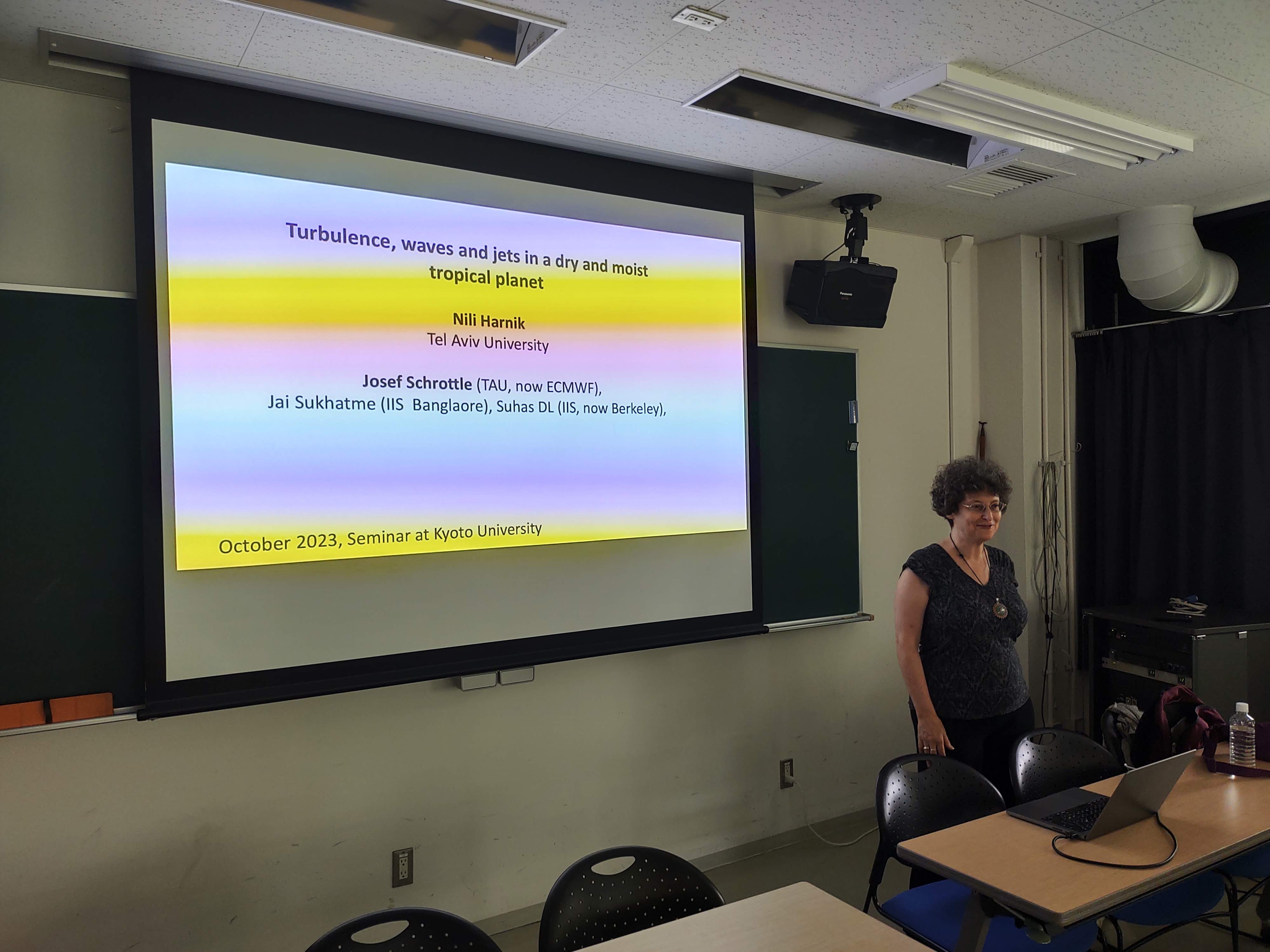
|
第21回 (2023年 10月05日 14:00-16:00) 1-563 |
Shira Raveh-Rubin(Weizmann Institute of Science・Senior Scientist) [タイトル・要旨] (1) "Dynamics of dry intrusion air streams and their relevance for high-impact weather" Dry intrusion (DI) air streams typically comprise the cold and dry sector of extratropical cyclones. These air parcels descend slantwise from the midlatitude upper troposphere towards the surface in lower latitudes, where the airstreams typically fan out behind the cyclone’s trailing cold front. In this talk I will outline recent results based on a Lagrangian-based global climatology of DIs using ECMWF reanalysis data, allowing progress in understanding the intrusions’ occurrence frequencies, dynamical interactions and association with extreme weather. Using representative case studies and longer-term climatologies we find that DI air starts its descent from the upper troposphere behind midlatitude troughs of Rossby waves, often associated with Rossby wave breaking. When interacting with cyclones in the storm tracks, they are associated with strong cold fronts in the cyclone southwest quadrant (in the northern hemisphere) and with marked anomalies in the lower troposphere. Namely, dry and cold anomalies prevail, which together with strong winds, enhance ocean heat loss and destabilize the lower troposphere. The modification of the lower troposphere by DIs entails strong associations with a diverse set of weather extremes, from heavy precipitation, strong winds and extreme cold temperatures, to wildfires and dust storms. For example, DIs enhance (i) the Mistral wind in southern France and its impact on deep convection in the water column in the Gulf of Lion; (ii) large-scale Saharan dust storms and long-range dust transport to Europe and the Middle East; (iii) wildfires in southeast Australia; and (iv) Indian summer monsoon precipitation. Overall, we find that surface extremes associated with DIs may extend beyond the midlatitudes, into subtropical and tropical regions. (2) "Process-based classification of Mediterranean cyclones" Mediterranean cyclones are responsible for extreme weather events extending from the Mediterranean basin to Europe, Africa, and the Middle East, affecting the lives of hundreds of millions. Despite continuous research and improved understanding of Mediterranean cyclones in the last decades, their accurate simulation and prediction remain a significant challenge at the weather and climate scales. A central challenge is the non-linear, multi-scale interactions that govern cyclogenesis and cyclone deepening, and their interaction with topography. Mediterranean cyclones are dominated by large-scale forcing for baroclinic instability, joined by diabatic processes in the mid-troposphere, and interactions with the land/ocean surface. While past studies classified cyclones in the region, none systematically distinguished different cyclone types in terms of the governing processes, limiting our understanding of their occurrence, impacts, predictability, and long-term changes. Here, we aim to classify Mediterranean cyclones across the basin, year round, by the governing processes during their deepening. To this end, we rely on the recent Mediterranean cyclones “best tracks” dataset from the MedCyclones COST Action for 1979-2020, and using a self-organizing map approach, we classify the cyclones into types depending on their potential vorticity (PV) distribution in the upper troposphere. The analysis reveals 9 distinct PV distributions, reflecting different flow structures associated with Rossby wave structures and breaking life cycles. Each cyclone type exhibits unique spatio- temporal distribution, (thermo)dynamical evolution and relative contributions of diabatic processes. The impacts of cyclones vary dramatically across the different types, suggesting the usefulness of adopting a process-based approach to cyclone classification. Based on this work, future directions for studying cyclone prediction will be put forward. |
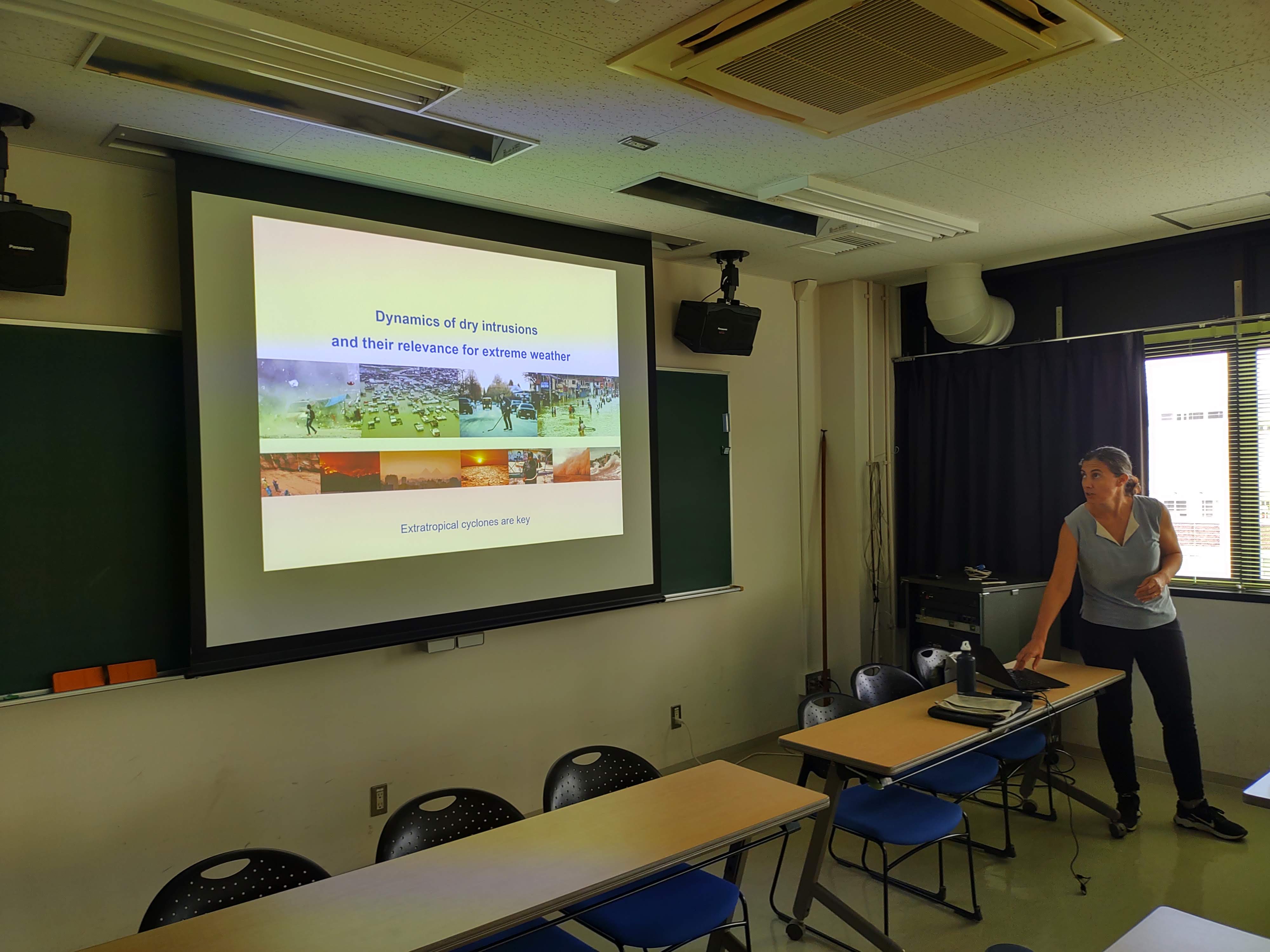
|
第20回 (2023年 9月27日 15:00-17:00) 1-462 & オンライン |
鈴木 賢士(山口大学創成科学研究科 教授) "新しい降水粒子撮像ゾンデの開発と今後への期待" |
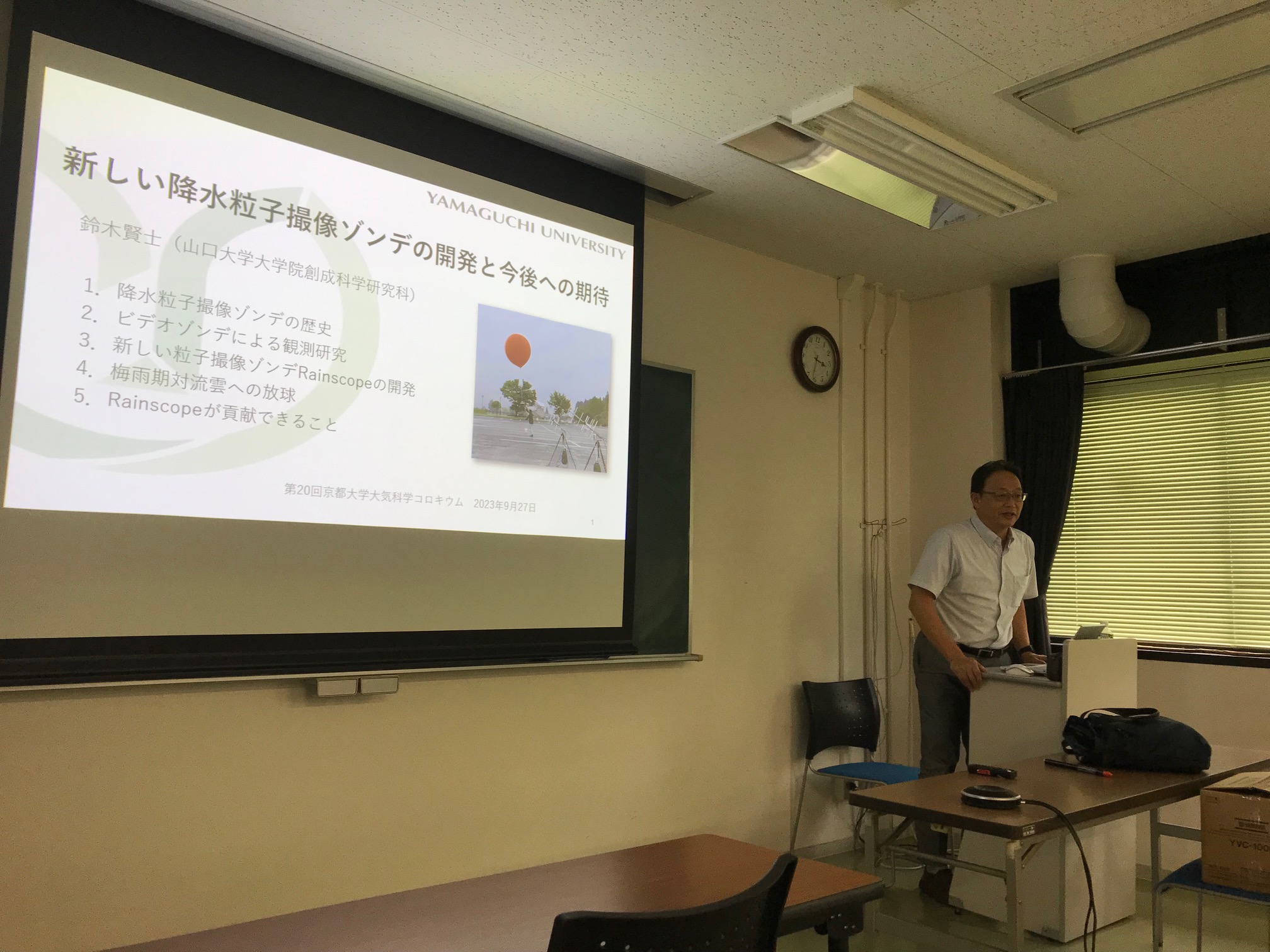
|
第19回 (2023年 7月27日 10:00-11:30) 1-462 & オンライン |
小郷原 一智(京都産業大学・准教授) "火星中緯度のダストストーム発生条件" [要旨] 火星においてダストストームが多発していることはよく知られているが,特に中緯度に集中している. しかも,地球のストームトラックのように,ダストストームが発生しやすい地域があることも知られている. しかし,中緯度のダストストームの発生メカニズムとして何かが提案されたことはなく,それが対流性のものなのか, 前線に伴うものなのか,どちらでもないのか,いまだに明らかになっていない. そこで本研究は,火星北半球中緯度のArcadia平原に注目し,ダストストーム発生時に典型的な大気環境を明らかにすることで, ダストストームの発生メカニズムを制約することを試みた.その結果,当該地域が地表付近の暖気中に位置しているときにダストストームが発生する傾向にあることが分かった. 総観規模の地表面応力はむしろ小さい領域であるので,当該地域のダストストームは大気が不安定化して発生しやすくなった対流性のものである可能性がある.火星観測画像からダストストームを検出し面積を測定するために深層学習を利用したので,その基本概念の説明にも時間を割く予定である. |

|
2022 (R4) 年度
| 実施回(月日) | 発表者(所属・身分): タイトル | 写真 |
第18回 (2023年 3月3日 13:30-15:00) 於 オンライン |
奥井 晴香(東京大学大学院理学研究科D2) "成層圏突然昇温に伴う成層圏・中間圏相互作用とそこでの重力波の役割" [要旨] 成層圏突然昇温(SSW)に伴う力学・温度場の変動は、成層圏のみならず中間圏にも及ぶ。これらの高度では重力波がプラネタリー波とともに力学場の決定に支配的な寄与をするが、 中層大気全体での重力波の振る舞いはその小さな時空間スケールゆえに観測的・数値的研究が難しく、十分な理解に至っていない。 本研究では、重力波を解像でき全中性大気をカバーする大気大循環モデルを用いて、2019年北半球SSWの再現実験を実施した。 この結果を用いて、SSW発生時の成層圏・中間圏相互作用とそのメカニズムを、特に重力波とプラネタリー波の協働に着目して調べた。 大昇温発生の8日ほど前には、極域中間圏に東風が形成され、極域上部中間圏に気温極大が現れていた。 東風の形成はおもに重力波強制によって起こり、この領域で生じた平均場の力学的不安定によりプラネタリー波が放射され、気温極大形成に寄与したと考えられる。また、東風の下ではプラネタリー波の強い収束がみられた。このことは、重力波強制による中間圏での東西風の逆転が、同時に発生した成層圏での極渦の極向きの移動とともに、SSWの発生に寄与したことを示唆する。 |
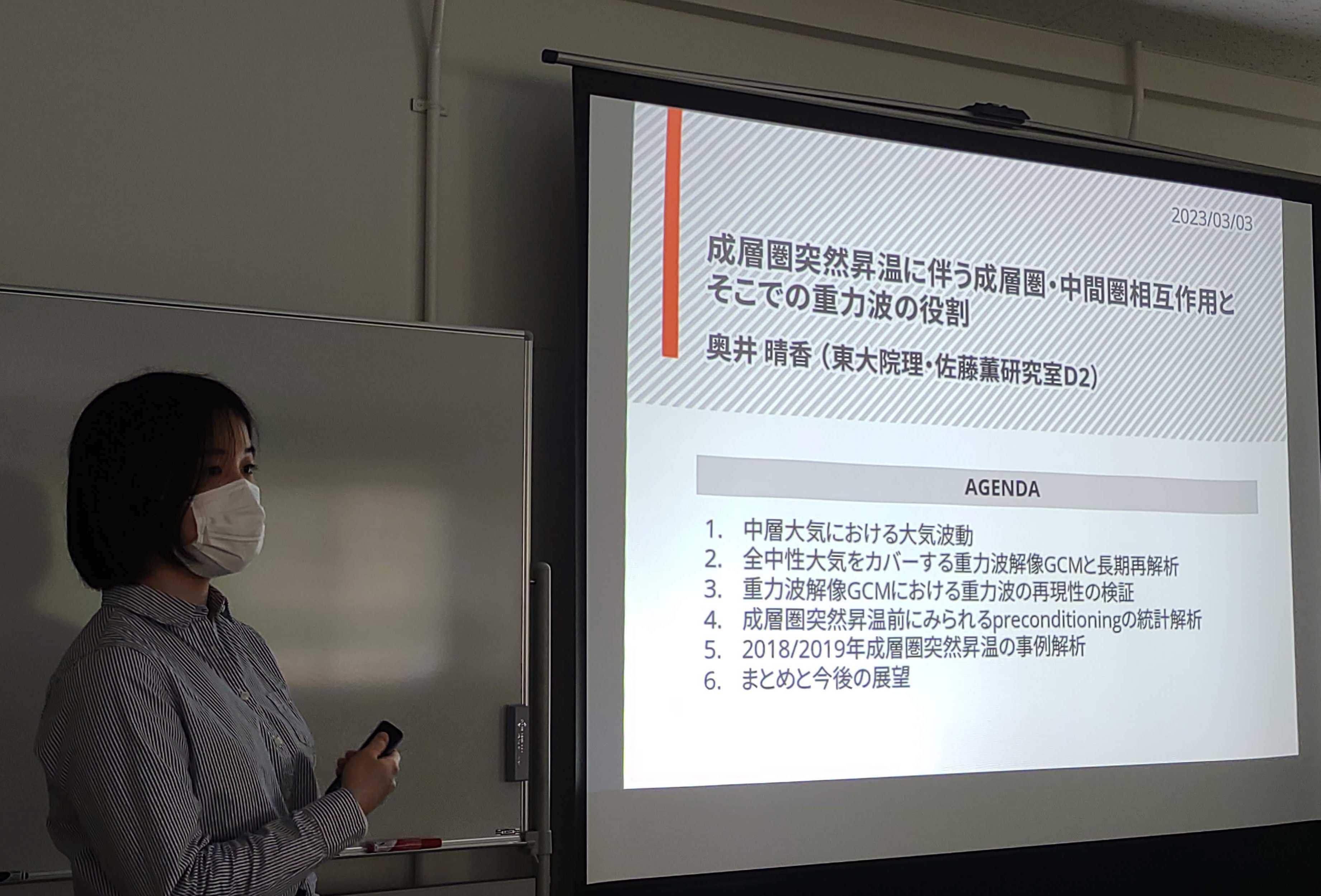
|
第17回 (2022年 12月23日 13:30-15:00) 於 オンライン |
尾上 万里子 (Stony Brook University, Research Assistant Professor) "マルチパラメータ、多周波レーダーを用いた層状性降水システムの降水過程の観測" [要旨] 降水粒子の形成過程は降水システムや地域によって変動が大きく、その観測・解明は長年の課題である。近年、水平解像度1 km以下の高解像度の気象シミュレーションが一般化してきた。使用されるモデルや 解像度によっては乱流や雲・降水粒子の粒径分布も表現される一方で、それらを評価するための高時間・空間分解能の観測の重要性も再認識されている。 マルチパラメータレーダーとして知られる二重偏波レーダー(dual-polarization weather radar)は水平・鉛直方向に偏光した電波を送受信することで、レーダー反射強度とドップラー速度に加え、 様々な偏波パラメータを取得する。偏波パラメータは雲・降水粒子の形状や相、数濃度と強い関係を持つため、これらの雲物理量を推定するのに有効である。加えて、多周波数のレーダーを用いることにより、散乱領域の 違いによる粒子サイズ・タイプの推定が可能となる。本発表では、マルチパラメータレーダーまたはマルチパラメータレーダーを含む多周波レーダーによる観測的研究を紹介する。梅雨期の降水システムでは、 前線からの相対位置の違いに伴い、雨粒の粒径分布の異なる対流セルが観測された。北極域では水・氷粒子混合層に伴う雪粒子の形成過程、アメリカ東海岸では雪粒子の凝集・ライミング過程を観測し、それらの 降水過程について考察した。 |
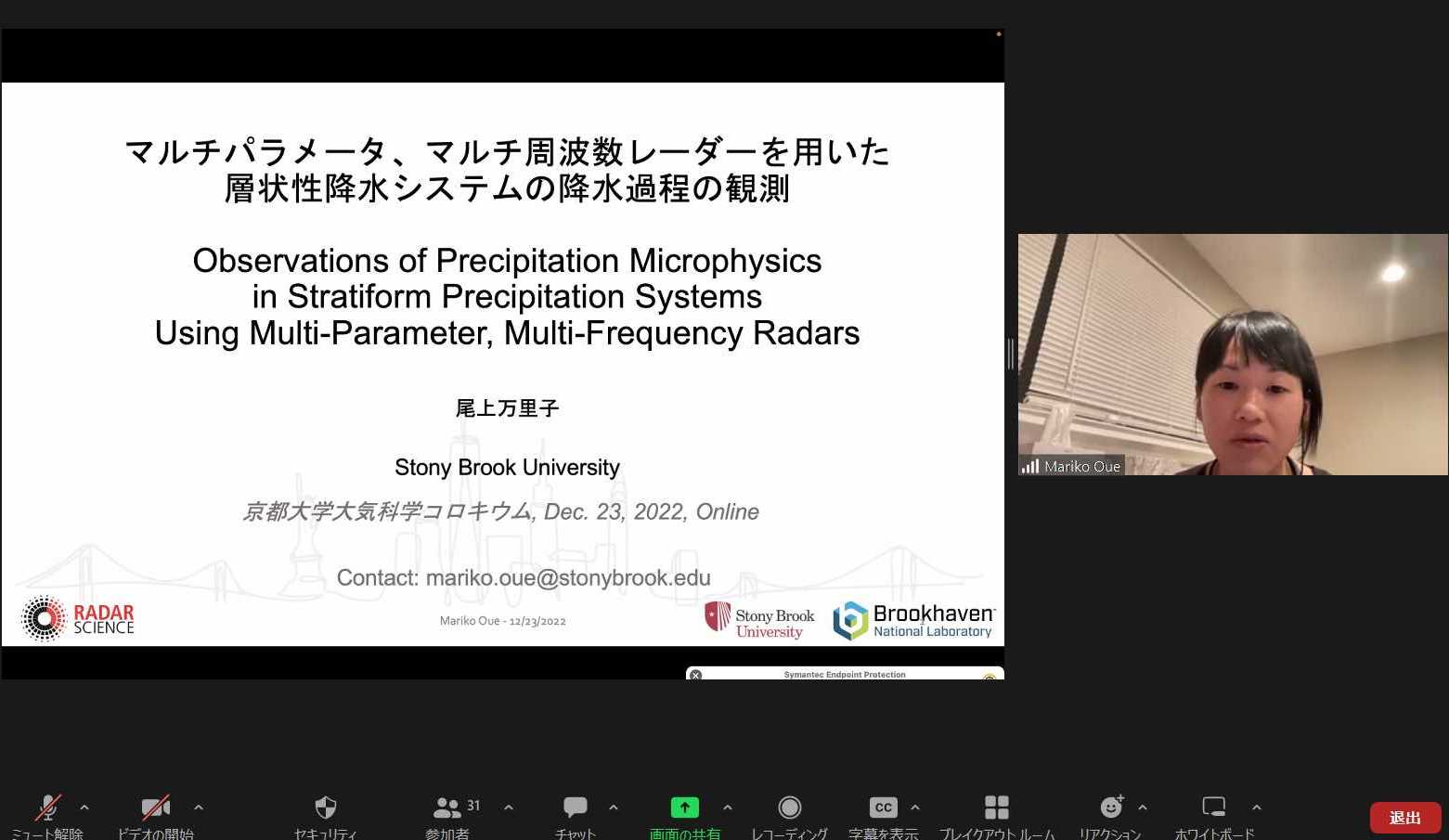
|
第16回 (2022年 09月30日 13:15-15:15) 於 1-264 |
(1) Ulrike Langematz (ベルリン自由大学・教授): "Sensitivity of the Pacific Walker Circulation to Solar Variability" [要旨]The Pacific Walker Circulation is a large-scale atmospheric circulation cell in the longitude-heightplane over the equatorial Pacific Ocean. The Walker Circulation features low-level easterlies across the central Pacific, rising motion over the warm western Pacific, returning flow from west to east inthe upper troposphere, and sinking motion over the cold eastern Pacific. The Walker Circulation is the atmospheric part of the El Niño-Southern Oscillation (ENSO), as it is modulated by tropical seasurface temperature anomalies during El Niño and La Niña periods. Here, we examine whether solar variability on the decadal and centennial time scales has the potential to affect the Walker Circulation. By analysing a new ensemble of chemistry-climate modelsimulations we assess the suggested Bottom-Up mechanism and compare the solar signatures in the Walker Circulation for the 11-year solar cycle (decadal forcing) and during a Grand Solar Minimum(centennial forcing). (2) : Tobias Spiegl (ベルリン自由大学・研究員) "Modelling the pathways and atmospheric impact of the AD 775 extreme solar proton event." [要旨] Prominent excursions in the amount of cosmogenic nuclides (e.g., 10Be and 14C) around AD 775 document the most severe solar proton event (SPE) throughout the Holocene. Its manifestation in ice cores and tree rings are valuable for geochronology, but also for solar-terrestrial physics and climate modelling. Using different modelling approaches, including complex three- dimensional Earth system models, the transport, mixing and deposition of the cosmogenic nuclides produced by the AD 775 SPE have been investigated as well as its impact on atmospheric chemistry. In general, the modelled results are capable to capture the main char- acteristics (amplitude and decline) of the reconstructed timeseries from terrestrial archives quite well. It shows that the downward transport of the cosmogenic nuclides is controlled by the Brewer-Dobson circulation (BDC) in the stratosphere and cross-tropopause transport via tropopause folds or large-scale sinking. Clear hemispheric differences in the transport processes could be identified, leading to a different seasonal timing and geographical distribution of the surface fluxes, which are further modulated by the tropospheric seasonal variability. Over the last years, more and more of such extreme events have been detected within terrestrial proxy records, bearing the chance to test the robustness of the modelled results with respect to changing climatic background conditions. |
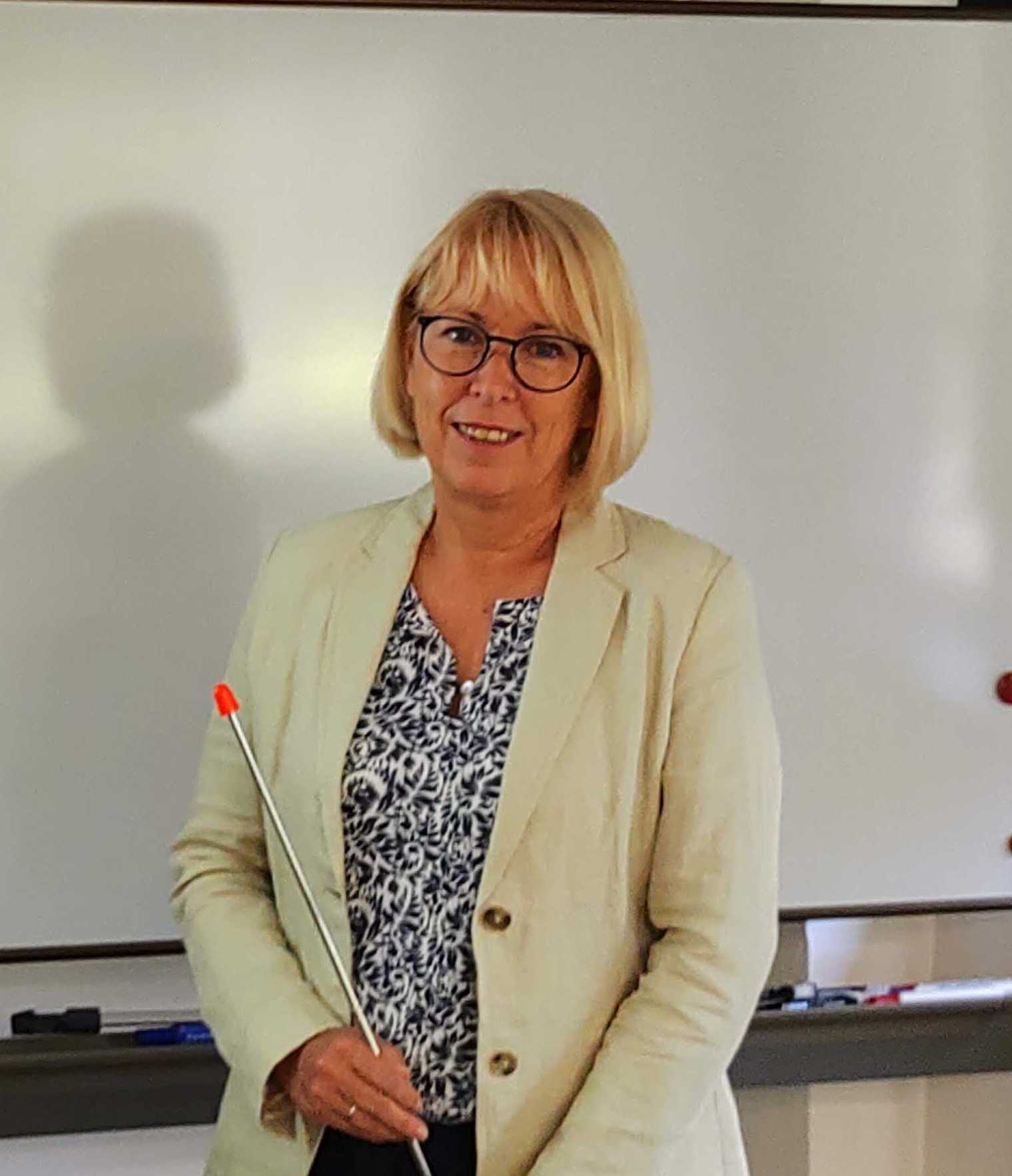  |
第15回 (2022年 07月08日 10:30-12:00) 於 1-264/オンライン |
伊藤耕介 (琉球大学理学部・准教授) "3次元的な藤原効果" [要旨] 2つの台風が接近すると、台風は「重心」を中心として、互いを反時計回りに回転させ、接近させる。この効果は、水平2次元的な流速場によって説明でき、藤原効果として知 られている。しかし、現実の台風は3次元的な鉛直構造を持っており、加熱の非軸対称性も台風の移動に寄与しうる。そこで、3次元的な挙動を明らかにするため、非静力学モデル WRFを用いて、f面上に2つの台風を配置する理想化数値実験を行った。数値実験の結果、2つの台風の間の距離が600 km程度である場合には、反時計回りの回転と接近が見られた が、1000 km以上の場合には、反時計回りの回転が弱くなるのに対して、台風が離れていくことが明らかとなった。そこで、渦位方程式を用いて診断したところ、1000 km以上離して 台風を置いた場合には、対流圏下層の渦位生成が「重心」から離れた側に偏在し、これがお互いを引き離す要因となっていた。そして、渦位生成の偏在は、対流圏上層での 2つの台風の吹き出しがなす高気圧性循環が個々の台風にとっての鉛直シアとして作用していたことにより生じていた。また、凝結に伴う加熱が無いとする感度実験では、2つの台風 がより接近した。現実の北西太平洋における台風の解析でも、加熱の偏在が2つの台風の移動に重要であることが認められた。 |
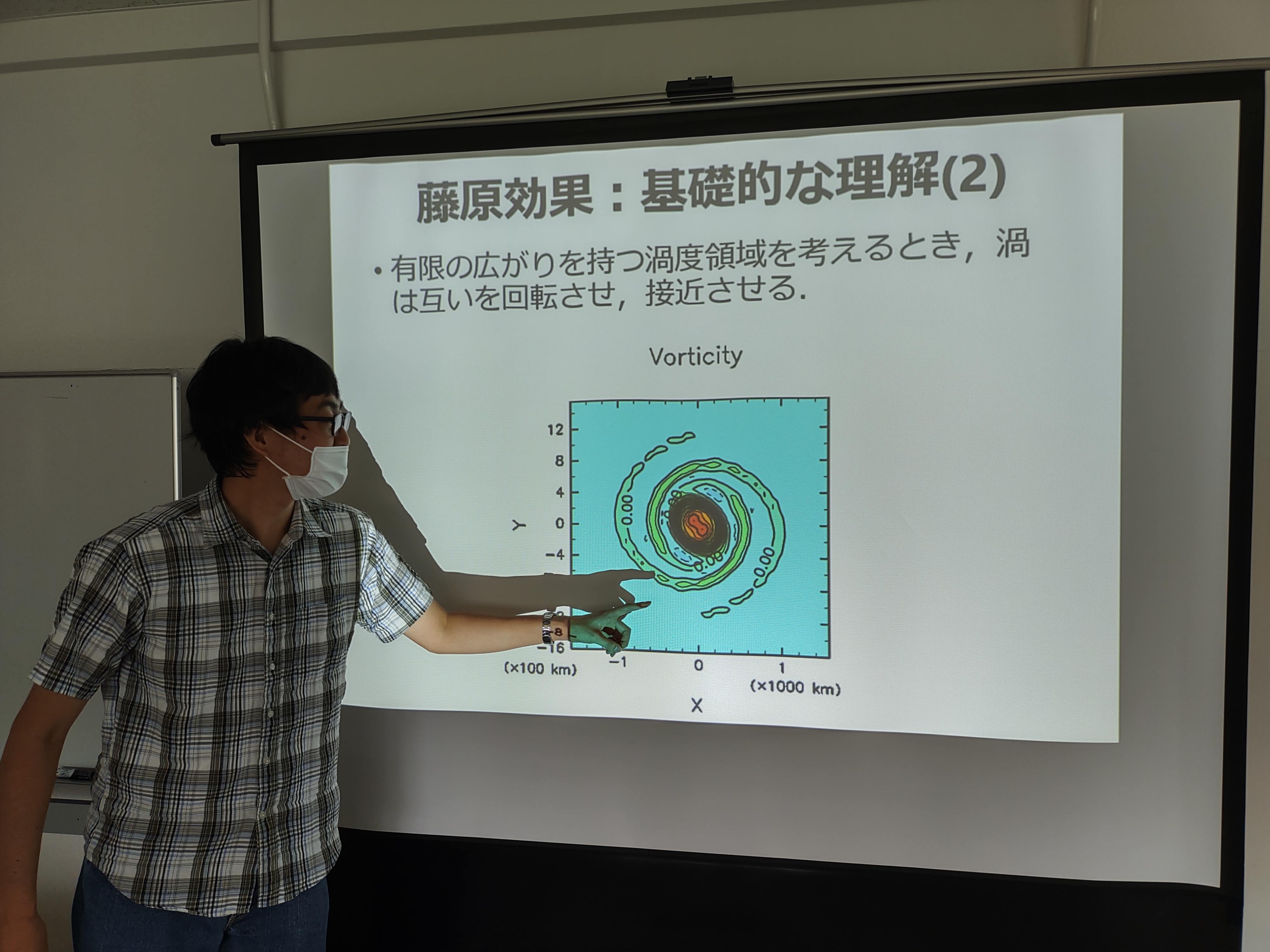
|
第14回 (2022年 05月06日 10:30-12:00) 於 ハイブリッド |
牛尾知雄 (大阪大学 大学院工学研究科・教授)"フェーズドアレイ気象レーダの研究開発と応用" [要旨] 近年増加傾向にある集中豪雨や積乱雲等の気象現象を,最短10秒で3次元で観測 することが可能なXバンドフェーズドアレイドップラー気象レーダを紹介する. このレーダでは,パラボラタイプのアンテナを機械的に回転させる方式に比し て,電子走査方式を用いることによって,観測に要する時間を従来に比して向上 させている. 2012年に一号機が,大阪大学吹田キャンパス電気系建屋の屋上に設置され,継続的に観測を行っている。本発表では,このレーダ開発の概要や観測結果,さらには応用事例を含めて概観し,今後の取り組みについても紹介する. |
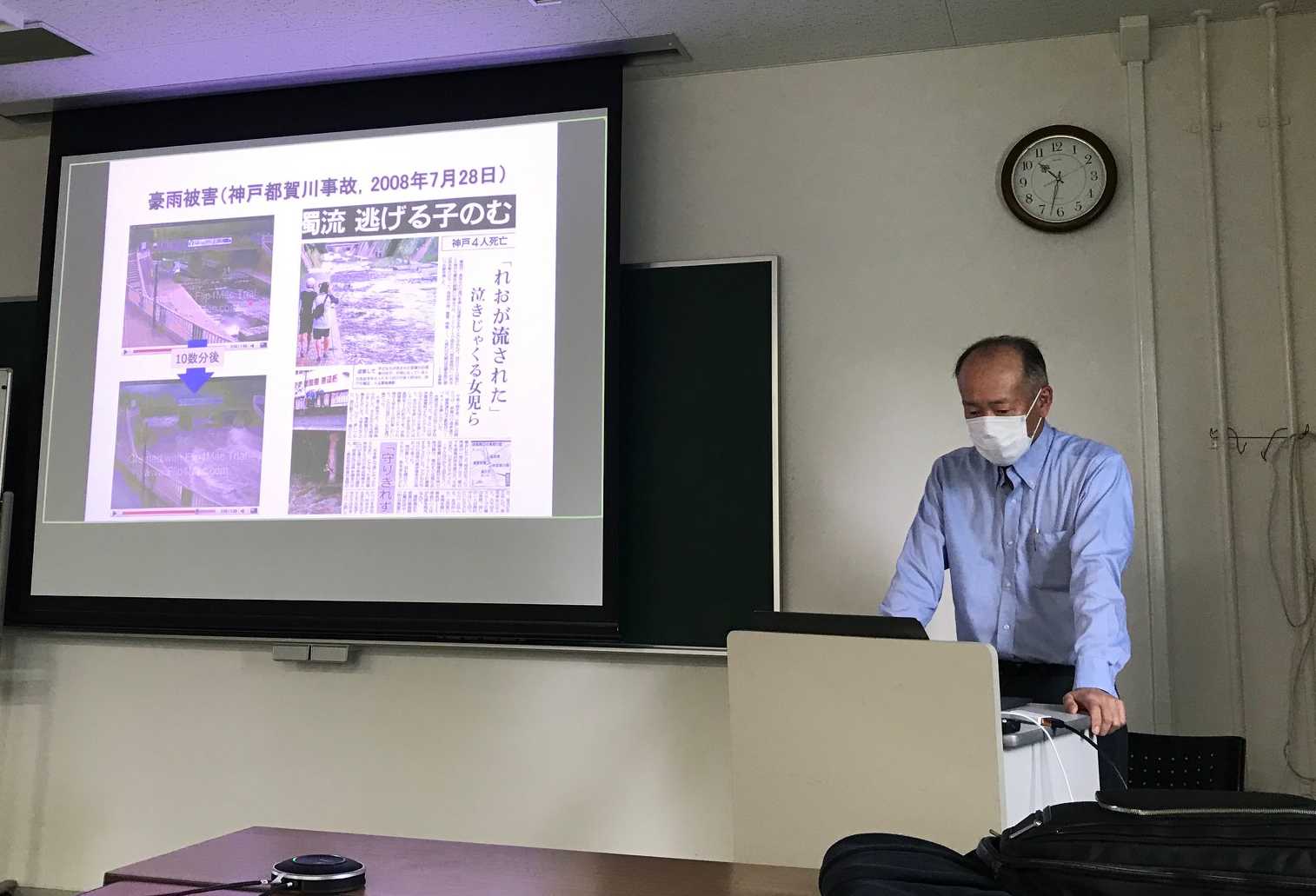
|
2021 (R3) 年度
| 実施回(月日) | 発表者(所属・身分): タイトル | 写真 |
第13回 (2021年 11月05日 13:15-14:45) 於 ハイブリッド |
内海信幸(京都先端科学大学ナガモリアクチュエータ研究所)"北西太平洋で観測された熱帯低気圧に伴う豪雨の変化傾向と気候変動の関係" [要旨] 熱帯低気圧は北西太平洋沿岸域における水災害の主要な要因の一つである.人為起源の温室効果ガス排出による気候変動により、熱帯低気圧に伴う豪雨(以下、台風豪雨と呼ぶ) の強度や頻度が変化することが予測されている.一方,観測では過去数十年間に北西太平洋の台風豪雨の頻度とその空間分布が変化していることが確認されている. しかし観測された変化が人為起源の気候変動によるものかは、未だ結論が得られていない.これは熱帯低気圧の自然変動が大きく,人為起源の気候変動の影響と自然変動の影響を 区別することが難しいためである. そこで本研究は観測に加え大規模アンサンブル気候予測データ(d4PDF)の解析を行い、北西太平洋域における台風豪雨の過去の変化傾向と気候変動の関係を調べた. 観測データの解析から,台風豪雨の頻度は過去数十年間に中国南西部沿岸から台湾,韓国,日本の本州にかけて増加し,ベトナム沿岸部の一部やフィリピンなど 北西太平洋の低緯度域では減少したことがわかった.一方,同様の空間的特徴はd4PDFの過去再現実験と非温暖化実験の差からも確認された. これは観測された台風豪雨の変化が気候変動の影響を受けていることを示唆している.そこでこれを確かめるため,Fingerprint analysisを行った.これは 台風豪雨の変化に含まれる気候変動影響のシグナルを検出するものである.この結果,北西太平洋で観測された台風豪雨の変化は自然変動のみでは説明できないことがわかった. これは,人為起源の気候変動の影響が北西太平洋の台風豪雨に既に現れていることを示している. |
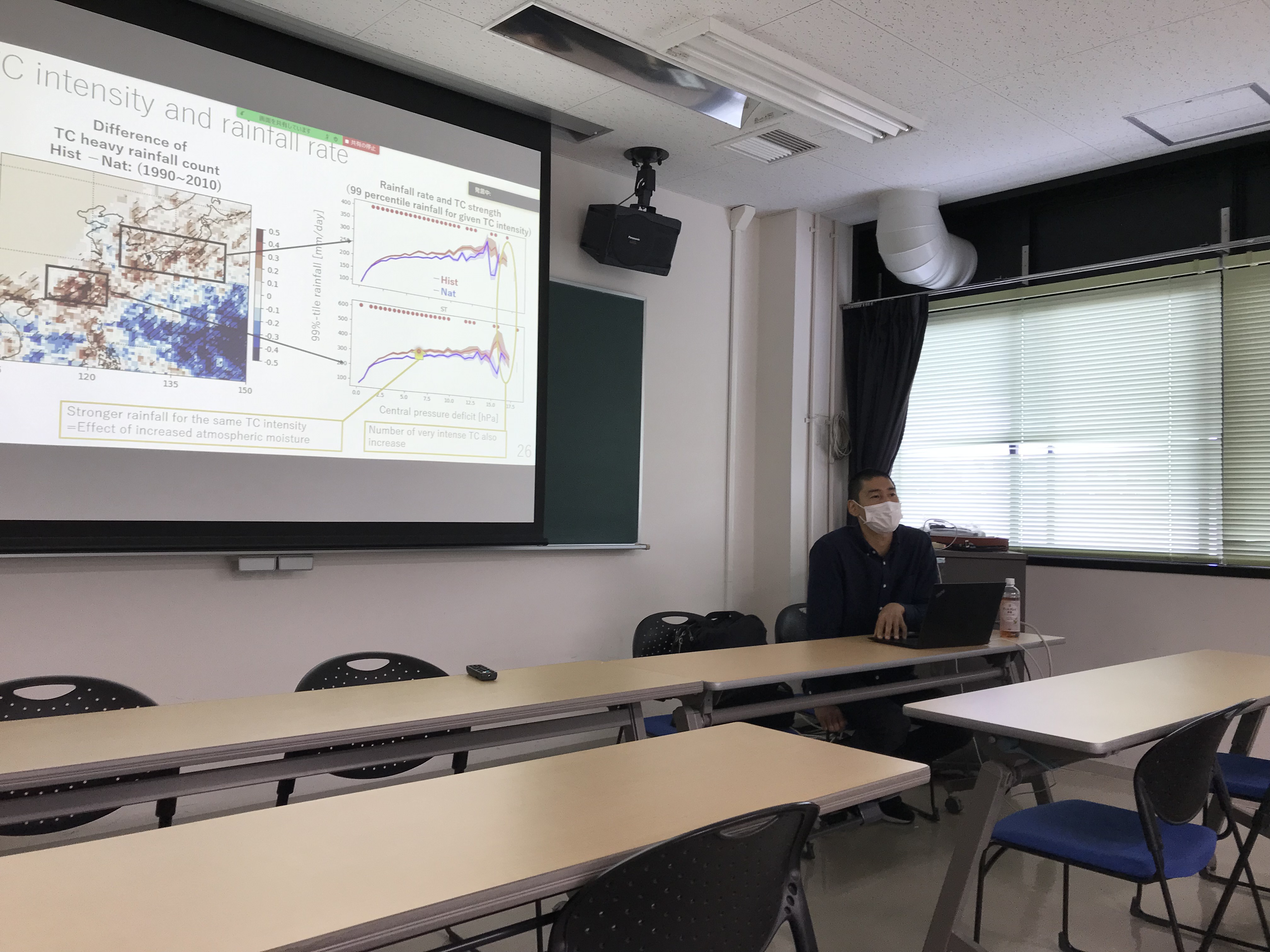
|
第12回 (2021年 9月8日 10:00-11:30) 於 Zoom |
藤原正智(北海道大学 大学院地球環境科学研究院・准教授)"後方散乱ライダーによるAsian Tropopause Aerosol Layer (ATAL)の研究" [要旨] Asian Tropopause Aerosol Layer(ATAL、アジア圏界面エアロゾル層)は、夏季にチベット高原~南アジアを中心とした領域の上空に 発達するチベット高気圧に伴うエアロゾル層である。チベット高気圧は、夏季アジアモンスーンの積雲対流と地表面加熱を起因として発達するが、 その際に、アジア諸国から排出された汚染物質やタクラマカン砂漠等からの鉱物ダストが対流輸送によって継続的に供給され内部に蓄積している。 ATALは、地球の放射収支への影響(地表面冷却、対流圏界面加熱)、下部成層圏オゾンの破壊促進、および、上部対流圏の巻雲粒子の特性変化に 関わっている可能性があるとされている。ATALは人工衛星観測により発見・命名され、その後いくつかの気球・航空機観測キャンペーンにより 確認されている。その組成については数値モデル実験や人工衛星観測により様々な仮説が出されている段階である。しかし、気球等による粒径分布の 現場観測はいまだに限られており、また、長期にわたる地上からの高精度観測の報告はまだなされていない。 チベット高気圧とそれに伴うATALは変動性も大きく、月に3回ほど大きく分裂して、東部の渦が東進して日本上空を覆い、数日をかけて北太平洋へ流出して いく「東方流出」という現象が存在している。この東方流出渦は、チベット高気圧内に局在するアジア起源物質をグローバルに拡散している過程として 近年注目されている。このことは、ATAL粒子の特徴を、日本上空で観測的に明らかにすることができることを意味する。本発表では、2018年の夏季について、 つくば(気象研究所)と福岡(福岡大学)のライダーデータを詳しく解析し、日本の高精度・高性能ライダーがATALの東方流出現象をとらえていることを 明らかにしたFujiwara et al., (ACP, 2021)の結果を紹介する。 なお、本発表は、地球惑星科学(地球物理学)特別講義2「高層気象観測の現代的意義」の一部である。 |

|
2020 (R2) 年度
| 実施回(月日) | 発表者(所属・身分): タイトル | 写真 |
第11回 (2020年 9月11日 15:00-16:30) 於 Zoom |
青木輝夫(国立極地研究所・特任教授)"急変するグリーンランド氷床" [要旨] 1990年代後半よりグリーンランド氷床の質量損失が加速している。氷床の質量損失は海水準の上昇をもたらし、 現在の上昇率に対する寄与は海水の熱膨張を除くとグリーンランド氷床の質量損失が最も大きいと見積もられている。 氷床全体の質量損失には氷床表面の融解と氷の流失量の増加の両方の効果が関係していると考えられている。そのうち表面融解には 気温の上昇だけでなく、それに伴う氷床表面のアルベド低下(「暗色化」と呼ばれる)が関係していると認識されているが、 その原因は十分定量化されていない。そこで、2000年以降のTerra/Aqau衛星のMODISデータから積雪物理量を抽出し、アルベド低下の 原因を調べた。その結果、涵養域では積雪粒径の増加、消耗域では裸氷域の拡大と雪氷微生物を含む暗色域の拡大が原因であることが 分かった。しかし、そのトレンドは単純増加ではなく、2012年以降大きな振幅が記録されている。それらとNAOなどの気候インデックス との関係などについても考察する。また、今後のグリーンランド氷床研究の課題について考える。 |
|
2019 (H31,R1) 年度
| 実施回(月日) | 発表者(所属・身分): タイトル | 写真 |
第10回 (2019年 11月13日 16:30-18:00) 於 1-264 |
Kevin Hamilton(University of Hawai'i・Professor emeritus): "The Quasibiennial Oscillation (QBO): Nonlinear Principal Component Representation and Applications" [要旨] This talk will describe a recently updated version of an earlier neural-network based statistical description of the QBO wind variations in the equatorial stratosphere (Hamilton and Hsieh, 2002). This work generalizes the usual principal component analysis (PCA) and produces a simplified representation of the observed QBO evolution. This approach nicely captures the regular (or “typical”) behavior of the QBO. I will show that this approach can also be used to characterize and forecast variations from typical or average behavior (for example the El Nino influence on QBO phase progression). K. Hamilton and W. Hsieh. Representation of the QBO in the Tropical Stratosphere Wind by Nonlinear Principal Component Analysis. J. Geophys. Res., 107, D15, ACL3-1-10. (2002). |
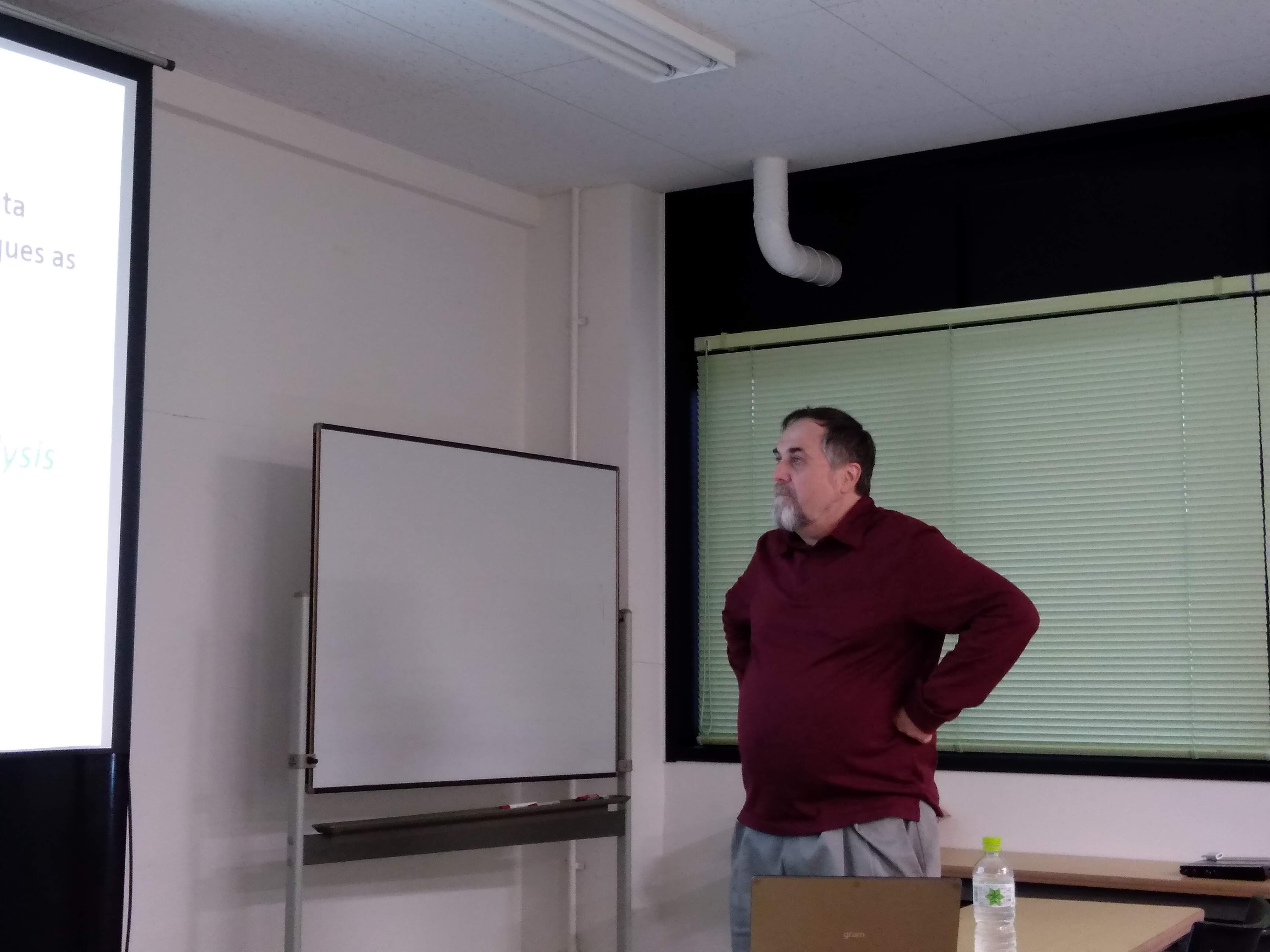
|
第9回 (2019年 9月24日 15:00-16:30) 於 1-264 |
Wei-Kuo Tao(NASA/Goddard Space Flight Center・Senior Research Scientist): "Goddard Microphysics: Status and Evaluation" [要旨] Advances in computing power allow atmospheric prediction and general circulation models to be run at progressively finer scales of resolution, using increasingly more sophisticated physical parameterizations. The representation of cloud microphysical processes is one of key components of these models. In addition, over the past decade both research and operational numerical weather prediction models have started using more complex microphysical schemes that were originally developed for high-resolution cloud-resolving models (CRMs). In the paper, we described different microphysics schemes that are used in Goddard Multi-scale Modeling System. There are three major models, Goddard Cumulus Ensemble (GCE), NASA Unified Weather Research Forecast (NU-WRF) and Multi-scale Modeling Framework (MMF) model, in this modeling system. The microphysics schemes are Goddard three class ice (3ICE) and four class (4ICE) scheme, Morrison two moments (2M) 3ICE, Colorado State University Regional Atmospheric Modeling System (RAMS) 2M five class ice (5ICE) and spectral bin microphysics schemes. The performance of these schemes are examined and compared with radar and satellite observation. In addition, the inter-comparison with different microphysics schemes are conducted. Current and future observations needed for microphysics schemes evaluation as well as major characteristics of current microphysics are discussed. |
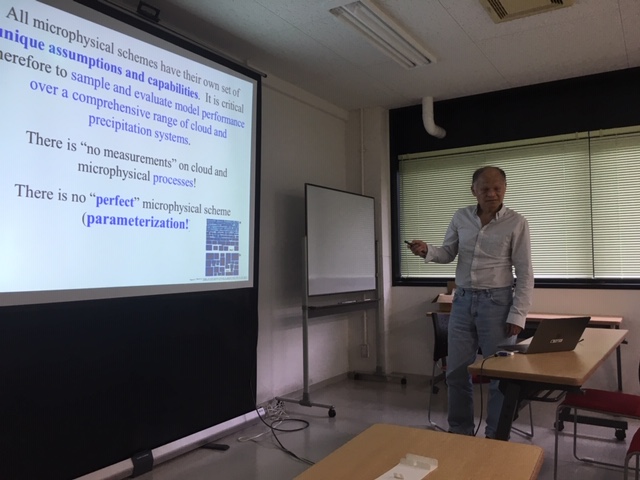
|
第8回 (2019年 8月8日 15:00-17:00) 於 1-563 |
(1) Yimin Liu (Institute of Atmospheric Physics (IAP), Chinese Academy of Sciences (CAS)・): "Thermal Structure of South Asia Anticyclone- Formation and Variability" [要旨] The upper troposphere – lower stratosphere above the TP and adjacent Asian monsoon region is a center of atmospheric components and has a unique anticyclonic circulation South Asian High. The warm anticyclone in the upper troposphere is deep and is superimposed by a cold anticyclonic in the lower stratosphere. The impacts of two types of heating on local vertical motion and anticyclone were compared. It is demonstrated that by changing the configuration of the upper-tropospheric air temperature and circulation, the two types of heating could generate both minimum absolute vorticity and abnormal potential vorticity forcing near the tropopause, enhance the meridional circulation of the Asian summer monsoon. While a strong diabatic heating above the plateau could results in biweekly oscillation of the South Asian High by enhance meridional gradient of the potential vorticity. (2) Anmin DUAN: "The Synergetic Effects Between the Tibetan Plateau and Tropical Ocean on the Interannual Variability of East Asian Summer Monsoon" [要旨] East Asian summer monsoon (EASM) is a land-air-sea coupling system, whose interannual variability receives combined regulations from both the thermal effects of the Tibetan Plateau (TP) and the global SSTA. We obtained the main progression through data analysis, numerical simulation and climatic dynamics application as follows. The leading mode of global sea surface temperature anomaly (SSTA) corresponds to the quasi-quadrennial ENSO cycle, which has a significant effect on the EASM. In summer of the positive developing years, the suppressed TP heating induces an anomalous cyclone over the Philippine Sea and suppress precipitation in East Asia. During the decaying years, the anomalous anticyclone over the northwestern Pacific, stimulated by the direct effect of SSTA, enhances the circulation and main rainfall band of EASM. The Indian Ocean basin mode (IOBM) and the TP heating make different contributions to the EASM. Their effects on upper-level circulation are similar. However, in the lower troposphere, the IOBM in warm phase enhances the anticyclone from the northwestern Pacific to the South China Sea, while the TP heating intensifies the low-level southerly in South China and the anomalous cyclone in North China, which converge the dry-cold and moist-warm flows to improve the main rain band of EASM. Thereby, the TP heating is more important than IOBM to impact the main rain band of EASM. (3) Bian He: "An introduction to LASG/IAP Finite-volume Atmospheric Model (FAMIL) version 2 for CMIP6 experiments" [要旨]The version 2.2 of Finite-volume Atmospheric Model (FAMIL), which is the atmospheric component of CAS-FGOALS-f3, is developed at the Institute of Atmospheric Physics/State Key Laboratory of Numerical Modeling for Atmospheric Sciences and Geophysical Fluid Dynamics (LASG). The model has recently been fixed to participate CMIP6 experiments, and the DECK AMIP experiments are evaluated in this study. The basic performances on capturing the climate mean state, interannual variability and intraseasonal variability are presented. The results suggest that FAMIL can reproduce well the climate mean geographical distribution of surface pressure, radiation, temperature and precipitation. For the climate variability, FAMIL captures the major modes of Pacific-North America teleconnection and North Atlantic Oscillation. The climate mean and trends of global monsoon annual range have also been well reproduced. In addition, FAMIL reproduces well the MJO propagation features and the associated wavenumber-frequency, which improves from last CMIP5 version. The major biases in FAMIL are also documented. FAMIL simulates stronger Asian summer monsoon with excessive precipitation in the western Pacific and dry bias over land. Meanwhile, the northward propagation of ISO in boreal summer is much weaker than the observation, which contribute to the climate mean bias of precipitation. The model development and future plans are also documented and discussed. (4) Wenting Hu: "Dominant patterns of winter-time intraseasonal surface air temperature over the CONUS in response to MJO convections" [要旨] The dominant patterns of the intraseasonal surface air temperature (SAT) over the Contiguous United States (CONUS) during wintertime (December-March) are investigated in the period of 1979-2014 in the present study. The first two leading modes revealed by the empirical orthogonal function (EOF) analysis sufficiently represent the patterns by explaining nearly 80% of the total variance. The EOF1 mode has a monopole pattern with large loadings in the central-north CONUS, while the EOF2 has a dipole pattern with loadings of opposing signs in the northwestern and southeastern CONUS. The monopole pattern of the EOF1 has a significant lead-lag correlation with the EOF2 dipole pattern. These dominant patterns are traced back to the convective anomalies of the Madden-Julian Oscillation (MJO) which has eight phases characterized by the revised real-time multivariate MJO (RMM-r) index. The connections are established dynamically by Rossby wave trains propagating from the MJO convections to North America. Specifically, the monopole warming (EOF1) is well developed by lagging about two pentads from enhanced MJO convections during phase 4 over the Maritime Continent as the wave sources. The dipole pattern (EOF2) of “warm-West/cool-East” starts to develop during MJO phase 7 with enhanced convections over the Western Pacific and reaches a maximum about two pentads later. Such dynamic lead-lag relationships on intraseasonal time scales are revealed by both diagnostic analysis and numerical experiments using a linear baroclinic model, which are potentially useful for predicting intraseasonal variations in SAT over the CONUS. |
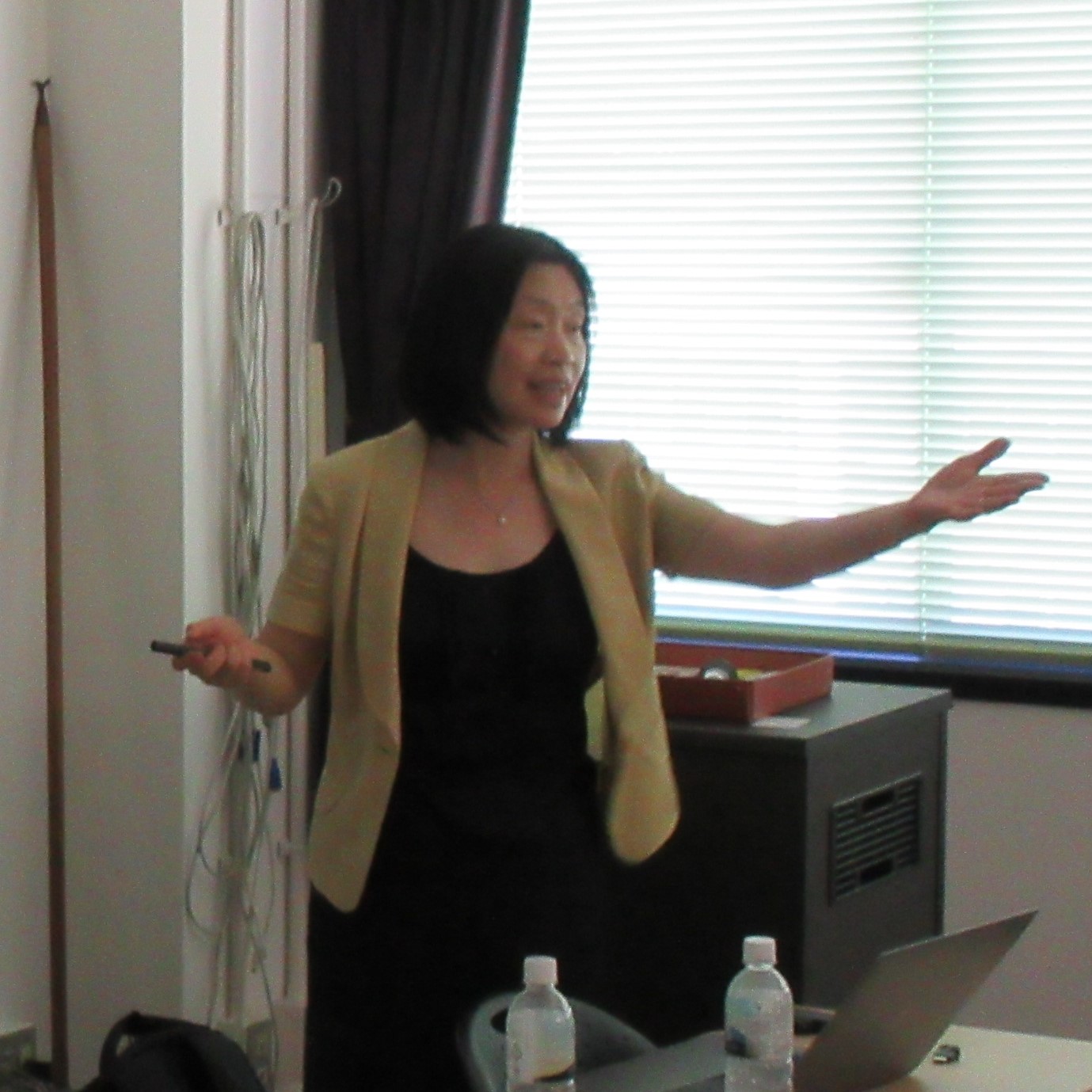 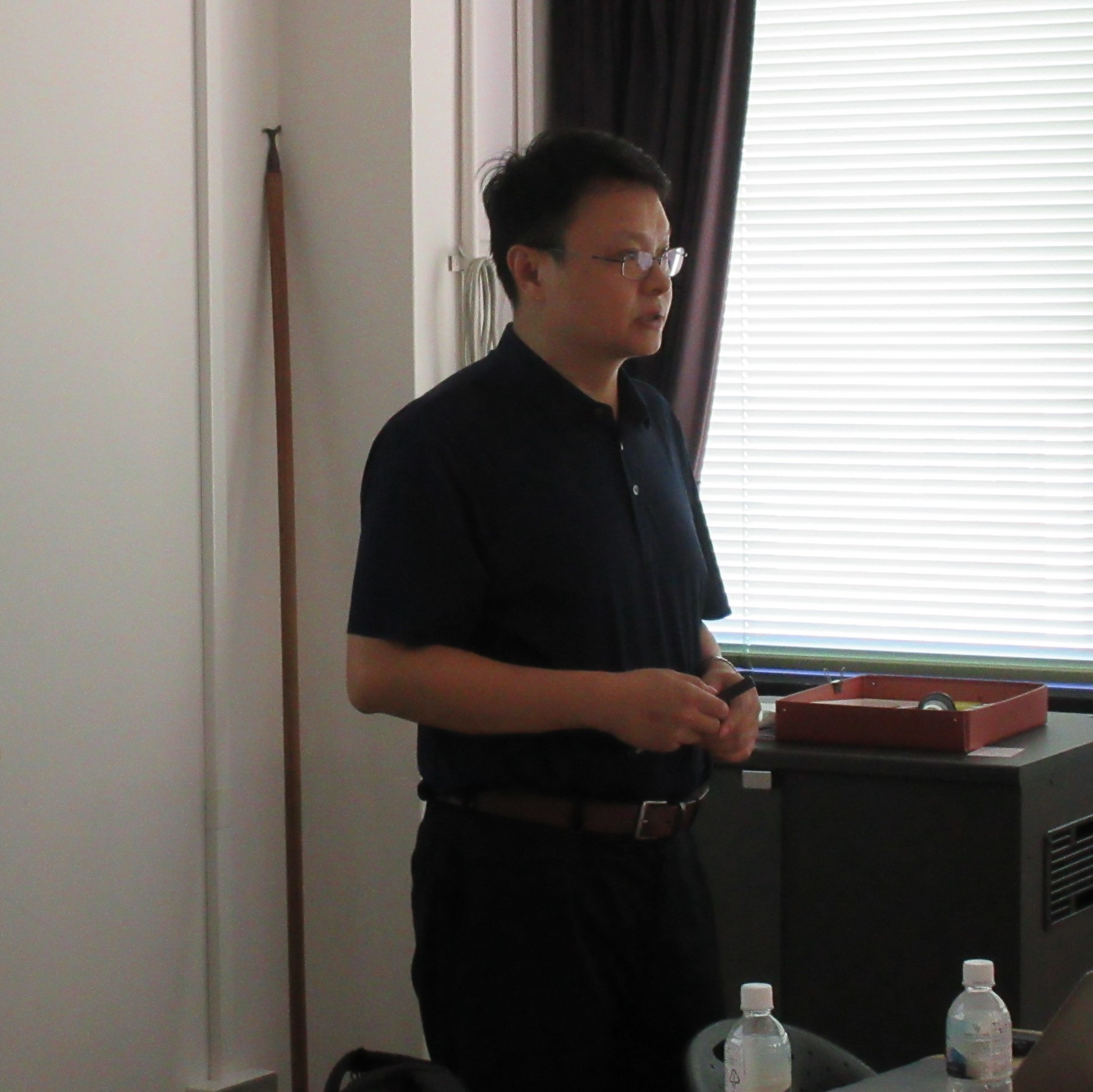 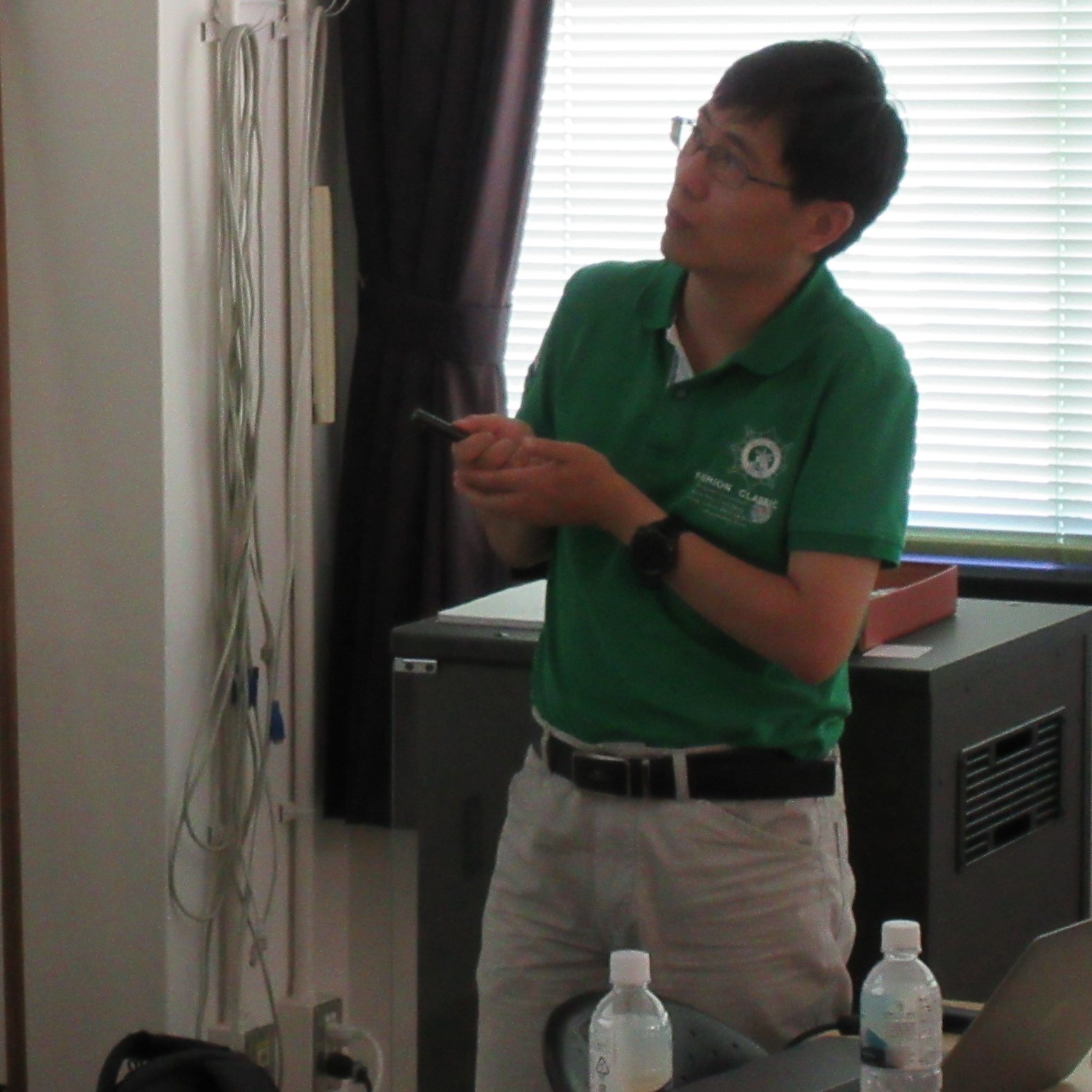 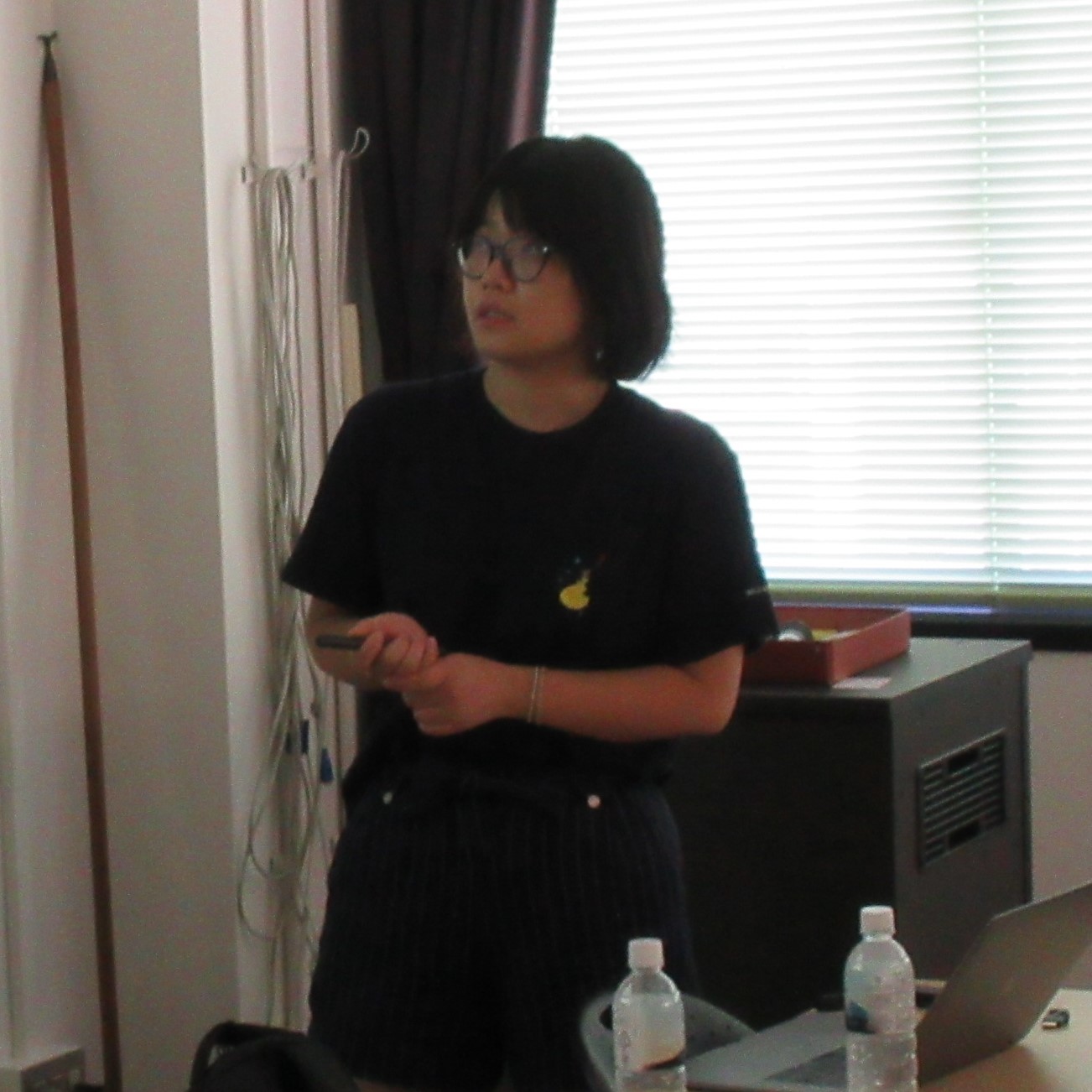 |
第7回 (2019年 7月17日 10:30-12:00) 於 1-462 |
広瀬正史(名城大学・准教授): "衛星搭載降水レーダによる高精細降水マップの特徴" [要旨] |

|
第6回 (2019年 5月13日 14:45-16:15) 於 1-563 |
Tobias Spiegl (ベルリン自由大学・研究員): "Hotspots of future climate change under
Grand Solar Minimum conditions" [要旨] Observations and model projections suggest heterogeneous warming patterns due to the rise of anthropogenic greenhouse gases, revealing different degrees of regional climate vulnerability. However, climate vulnerability in a certain region is not only defined by single parameters, e.g. near surface temperature, but also depends on seasonal changes in the variability and occurrence of extreme events. While the magnitude of 21st century climate change will be dominated by the amount of carbon dioxide emissions, external climate forcing may amplify or dampen the human induced signal. The main source of external variability in the terrestrial climate system is the Sun. Satellite measurements show a gradual decrease in solar output over the last three decades. This raises the question whether a prolonged downturn in solar activity and an associated hypothetical global cooling might counteract a man-made global warming. Like the anthropogenic imprints, the effects of a solar downturn are multidimensional. Here, we quantify the multidimensional climate change due to both, the future anthropogenic and solar forcing. We found, that the regional climate hotspots start to emerge during the early 21st century within the tropics. Throughout the 21st century the hotspot spread to the lower latitudes. Whereby the midlatitudes show a response to the rise of greenhouse gases which is below-average, even at the end of the century. Our findings suggest, that an extreme solar downturn is needed for a longer-term mitigation of the anthropogenic climate effects. In the course of that, the thermal inertia of the oceans is responsible for the delay in the anthropogenic climate signal. |
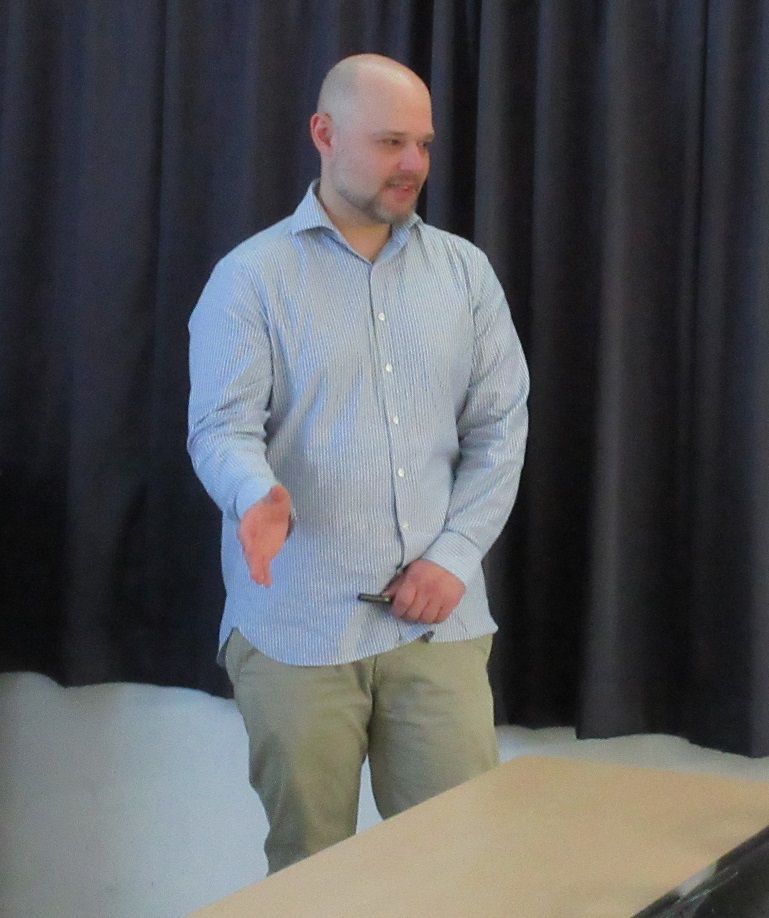
|
2018 (H30) 年度
| 実施回(月日) | 発表者(所属・身分): タイトル | 写真 |
第5回 (2019年 2月21日 16:00-17:30) 於 1-462 |
Ulrike Langemaz (ベルリン自由大学・教授): "The 'ozone hole' ? still a risk?
Changes in stratospheric ozone and their implications for the troposphere" [要旨] The stratospheric ozone layer protects life on Earth by absorbing harmful ultraviolet radiation from the sun. 90% of the atmospheric ozone abundance reside in the stratosphere, however changes in stratospheric ozone may directly impact the troposphere. Concurrently with an increasing industrial production of chlorine-containing halogens in the 1960/70s, stratospheric ozone began to decrease. Several studies showed that halogens cause chemical ozone depletion in the stratosphere, and the fast growth of their concentrations led to a strong decline in stratospheric ozone during the 1980s and 1990s. The most dramatic example is the so-called Antarctic ozone hole, a severe ozone decrease occurring over Antarctica each spring. In response, regulations of the production and use of the so-called ozone depleting substances (ODSs) were adopted by the United Nations in the Montreal Protocol of 1987. As a result of the Montreal Protocol and further amendments and adjustments, the ODS concentrations began to level off and slowly decline. Since the beginning of the century, there is also evidence from measurements that stratospheric ozone has started to increase. Models consistently project a full return of global mean stratospheric ozone to undisturbed, historical values in the first half of the 21st century. However, because of complex dynamical and chemical interactions, the date of ozone recovery in different atmospheric regions will strongly depend on the future greenhouse gas scenario. Here, an overview on the evolution of the ozone layer in the recent past is given and new model projections of the future ozone from the upcoming “WMO/UNEP Scientific Assessment of Ozone Depletion” are presented. The role of climate change for future ozone is discussed as well as the impacts of future ozone changes on the troposphere. |
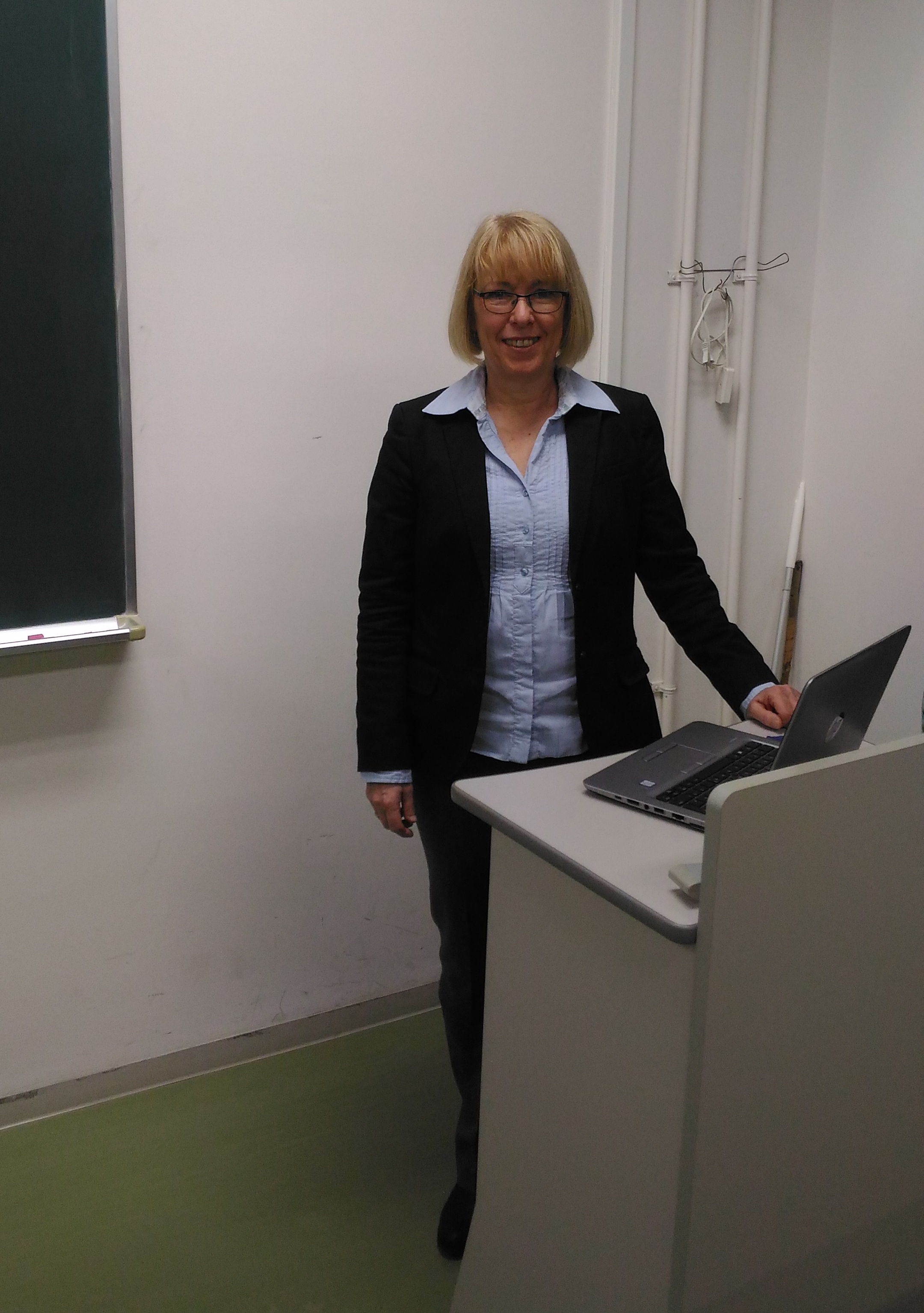
|
第4回 (2018年 12月20日 16:00-17:30) 於 1-563 |
Bjorn Stevens (マックスプランク研究所・所長/教授): "Experiences with RCE: Convective Aggregation, Land Surface Interactions, Cloud Feedbacks and
Climate Sensitivity" [要旨] Radiative Convective Equilibrium was introduced as a model problem fifty years ago to study the sensitivity of Earths surface temperature to radiative forcing. Today it has re-emerged as a popular framework which brings together a hierarchy of models: one-dimensional models with parameterized convection, large-eddy simulation, cloud-resolving models over large-domains, global cloud-resolving models and coupled climate models, to explore they dynamics of the Earth System. I will show snapshots from our work on RCE, how it identifies the role of shallow circulations in convective self aggregation on the one hand, and the convective dispersal over land on the other hand. We will show the important role of convective aggregation in modifying how the climate system responds to forcing, and explore the possibility of using this framework to study atmosphere-stratosphere interactions. |
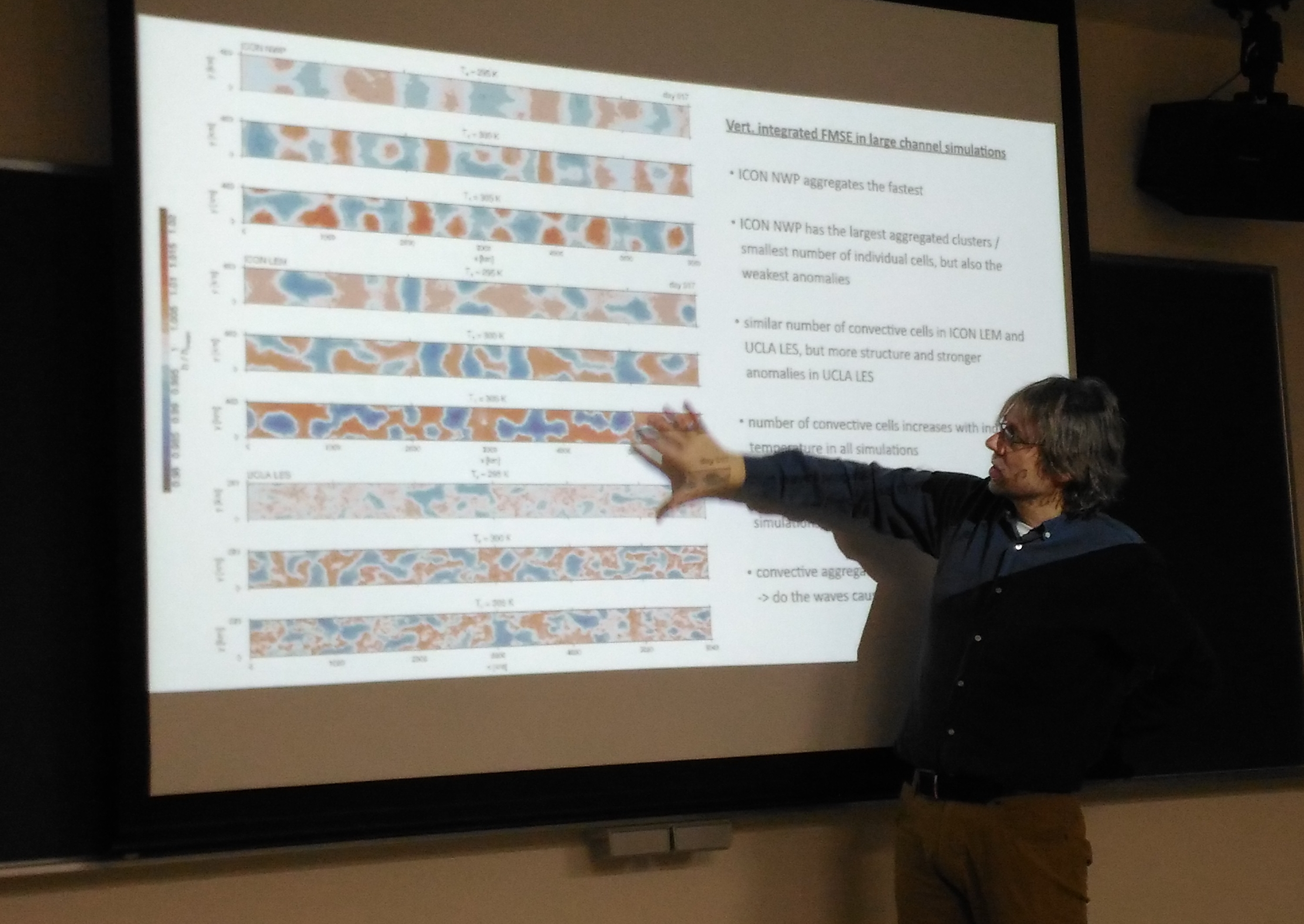
|
| 第3回 (2018年 11月26日 10:00-11:30) 於 1-563 |
Kevin Hamilton (ハワイ大・名誉教授): "What Do We Know About the QBO Behavior Over the Last 150 Years and What Does it Mean?" [要旨] The quasi-biennial oscillation (QBO) of the tropical stratospheric circulation was discovered in 1960 by analyzing the daily pilot balloon observations of the zonal wind over Kanton Island (2.8oS) that began in January 1953. By the mid-1960s investigators had analyzed the available observational data sets to provide information on the typical characteristics of the QBO and also to address the question of the “permanence” of the recently discovered oscillation in the period before 1953. Today, even with more than 65 years of daily balloon observations of the near-equatorial wind now available, it is not certain that we have a complete picture of the cycle-to-cycle and longer term variability of the QBO, an issue that was highlighted in 2016 when the QBO winds displayed a disruption of the usual pattern that was unprecedented in the post-1953 record. The types of evidence that may be used to extend knowledge of the QBO zonal wind into the past include: (i) the scattered pilot balloon observations from low latitudes available before 1953, (ii) the zonal wind inferred by tracking the stratospheric aerosol following large low-latitude volcanic eruptions, and (iii) barometric observations of the near-equatorial solar semidurnal tide which we know is affected by the winds in the tropical stratosphere. Fairly recently at least one investigator has made a tentative detailed reconstruction of the QBO winds back to 1900 based primarily on the barometric record. This talk will review earlier work and introduce my recent investigations into the pre-1953 QBO. I will consider speculations that the familiar QBO may have been subject to extensive interruptions in earlier times and place this in the context of projections of future QBO behavior changes in response to global warming. |
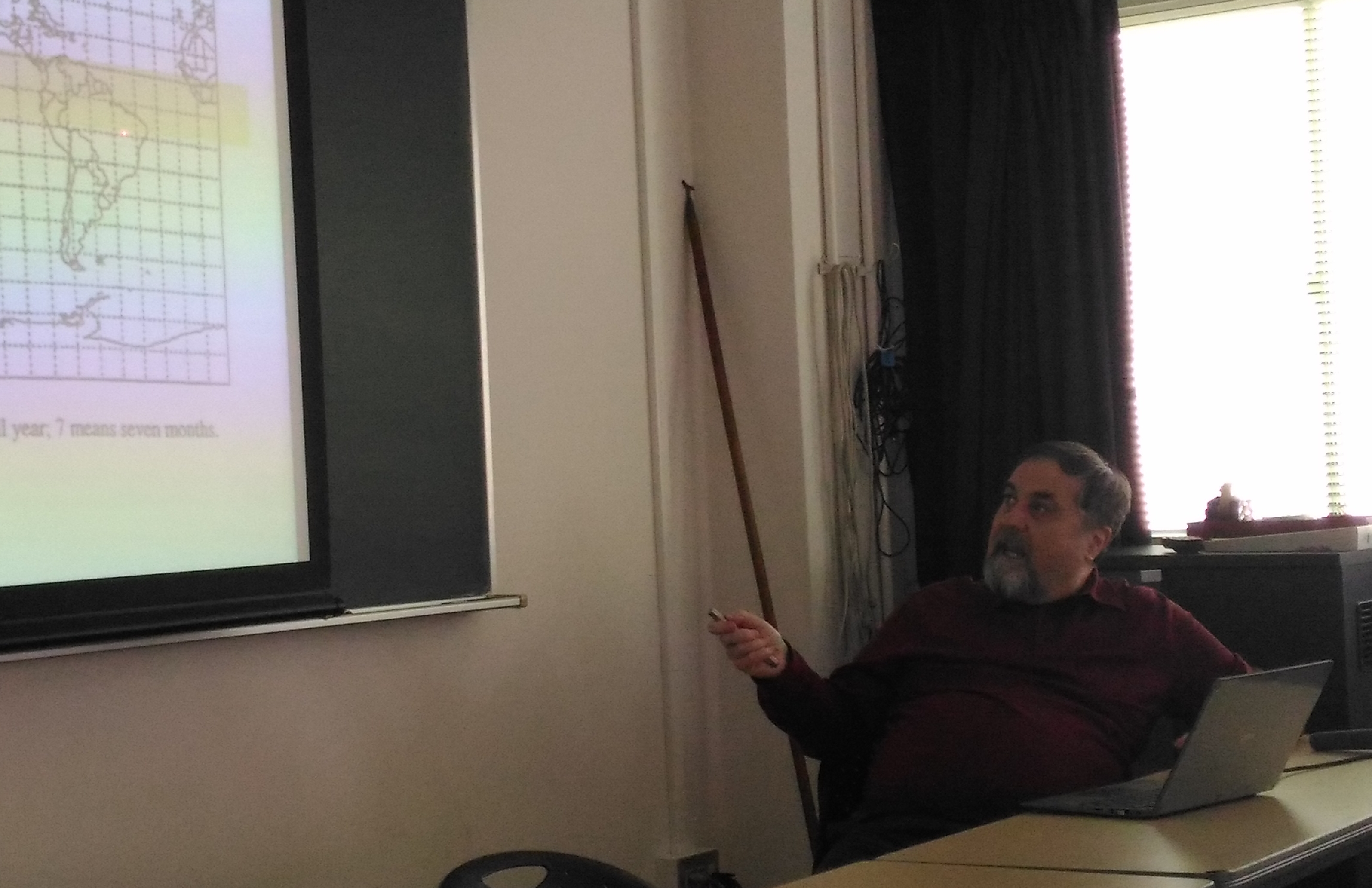 |
| 第2回(2018年 09月28日 15:00-16:30 於 1-563 |
倉本圭 (北海道大・教授):"ハビタブル惑星の成立を探る火星衛星探査計画MMX" |
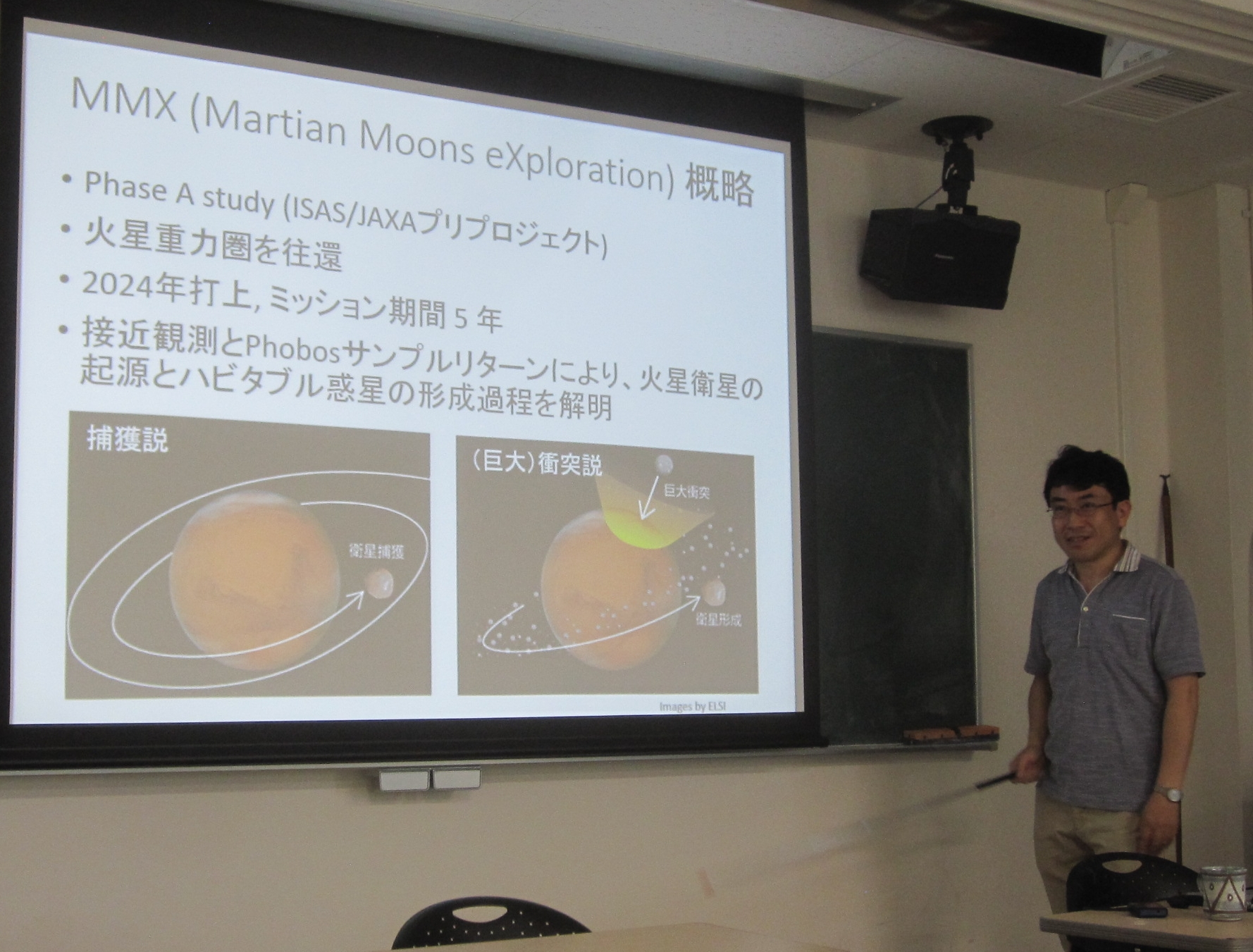
|
| 第1回(2018年 6月15日 10:00-11:30) 於 1-563 |
David W.J. Thompson (コロラド州立大・教授): "A key constraint on the depth of the extratropical troposphere" [要旨] In this talk, I will argue that the depth of extratropical troposphere is primarily constrained by the same physics that govern the temperature of tropical anvil clouds. That is: The extratropical tropopause is constrained by the rapid decrease with height of radiative cooling by water vapor in clear sky regions, and thus by the thermodynamic constraints placed on saturation water vapor pressure. The results suggest that the climate feedbacks associated with high cloud in the tropics are also important in the extratropics, thus roughly doubling the surface area affected by the positive high cloud feedback. They also imply that the extratropical tropopause should stay at roughly the same temperature and thus lift under climate change. |
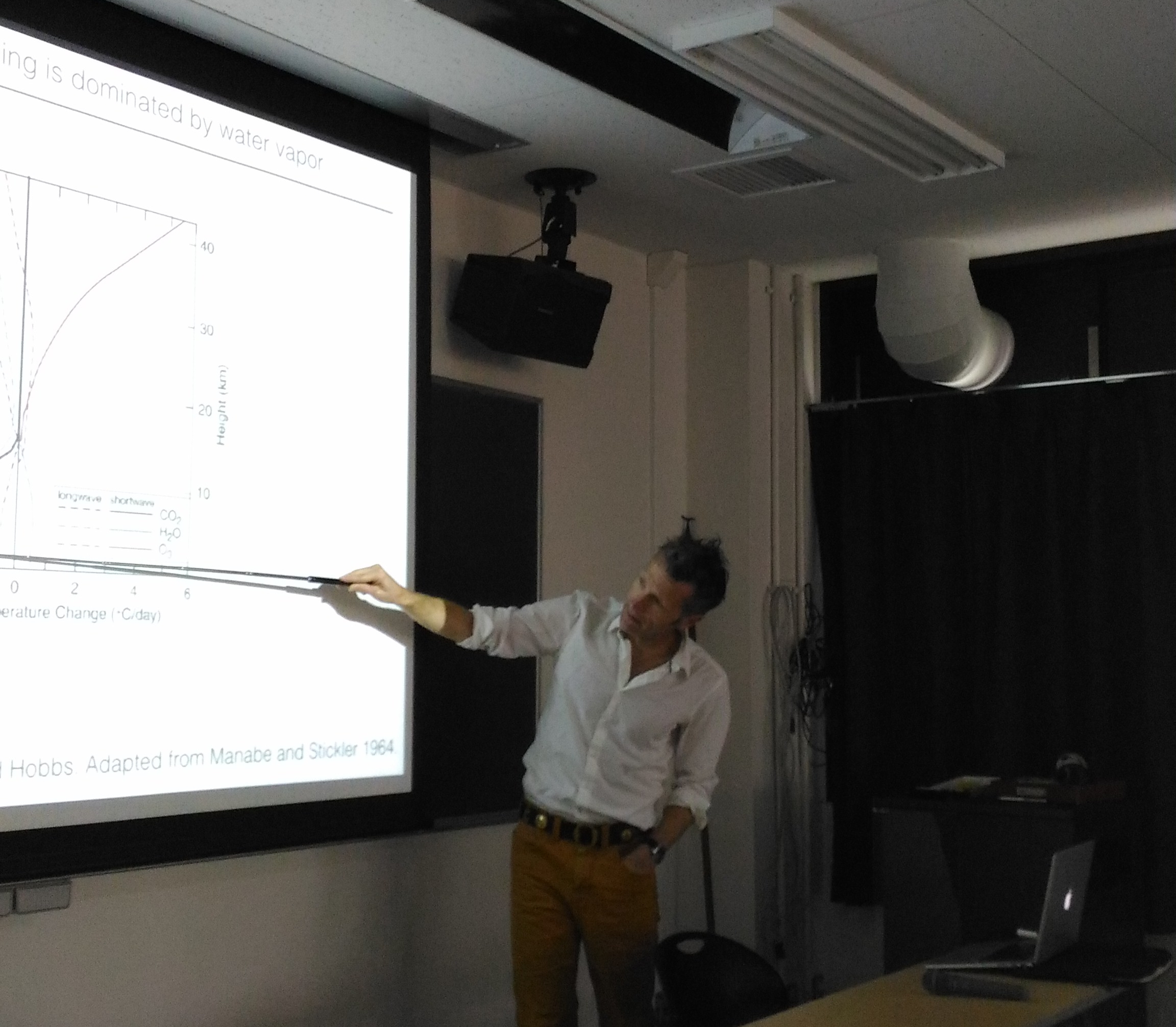
|
| (2018年 5月28日 14:30-16:00) 於 1-236 |
Hai Bui Hoang (ベルゲン大学・ポスドク研究員) "Influence of Sea Surface Temperature on Mid-Latitude Cyclones in an Idealized Framework" [要旨] Mesoscale oceanic features such as sea surface temperature (SST) fronts have potential impacts on mid-latitude cyclones evolution and trajectory. There is a need for a better understanding of how these mesoscale features interact with cyclones. While the essential mechanisms are sometimes difficult to be isolated from observations data and complex models, an idealized framework may serve as a useful tool. In this study, we investigate the influence of SST on mid-latitude cyclones using an idealized framework of moist baroclinic channel simulation. The initial balanced atmospheric fields are derived from an initial profile of zonal wind that resembles the jet stream. A series of experiments is designed to simulate different conditions of the SST including changes in the SST front location and strength. |
|
| (2018年 4月13日 13:00-14:30) 於 1-563 |
Yohai Kaspi (ワイツマン科学研究所・准教授): "Mechanisms controlling the spatial structure of midlatitude storm tracks and their dependence on climate change" [要旨] Midlatitude storm tracks dominate the transport of momentum, heat and water-vapor in the extratropics. Therefore, identifying the mechanisms governing their temporal and spatial structure is vital for understanding weather and climate. In this talk, we analyze the spatial structure of midlatitude storm tracks by tracking transient cyclonic eddies in an idealized GCM with several levels of complexity and in CMIP5 simulations. The localized atmospheric response is decomposed in terms of a time-zonal mean background flow, a stationary wave and a transient eddy field. The Lagrangian tracks are used to construct cyclone composites and perform a spatially varying PV budget. Three distinct mechanisms that contribute to the spatial structure emerge: transient nonlinear advection, latent heat release and stationary advection. The downstream evolution of the PV composites shows the different role of these mechanisms as the storm tracks evolve downstream. We demonstrate that the poleward motion of individual cyclones increases with increasing global mean temperatures, and by this provide an alternate quantitative explanation to the poleward shift of storm tracks under climate change. |
